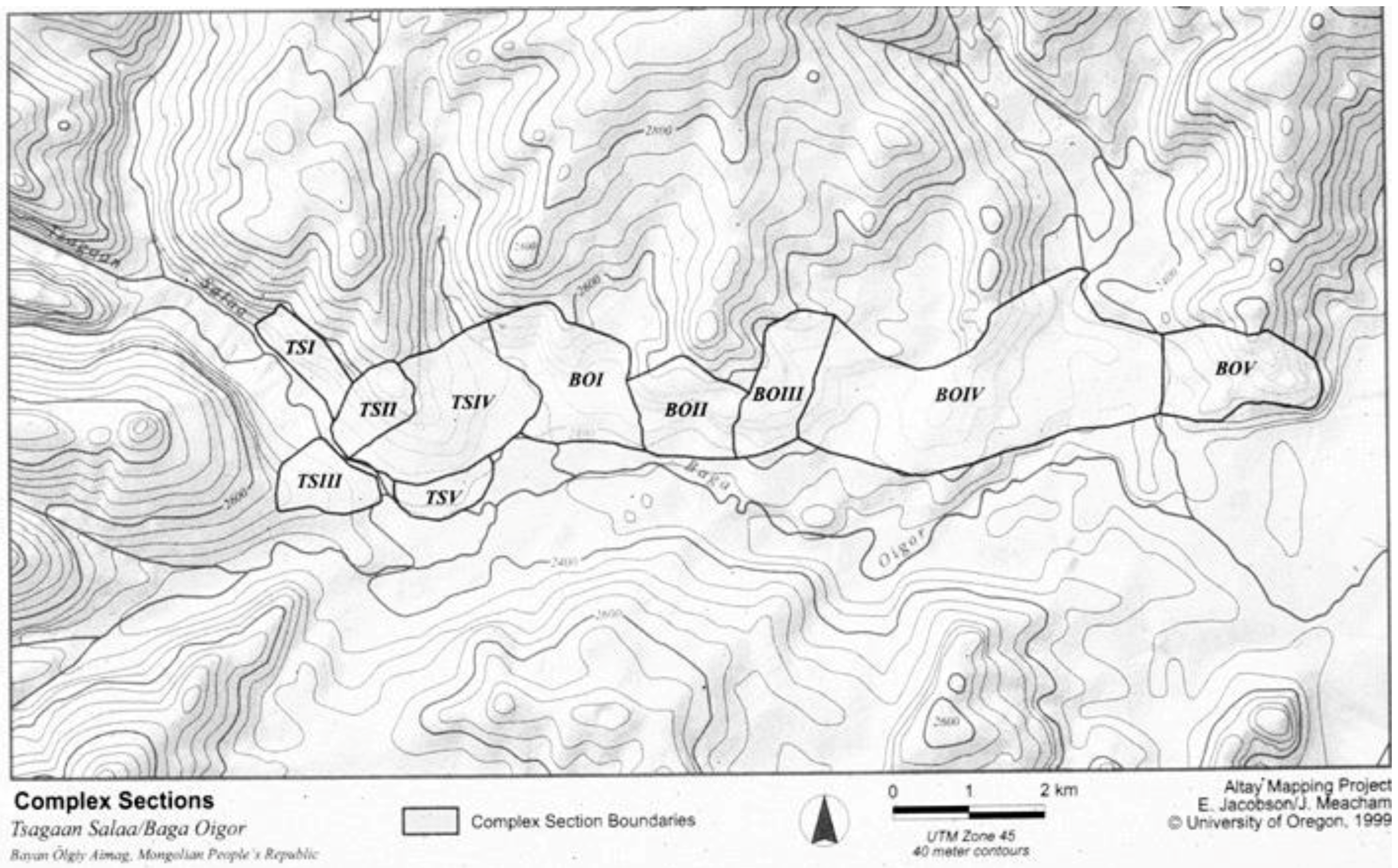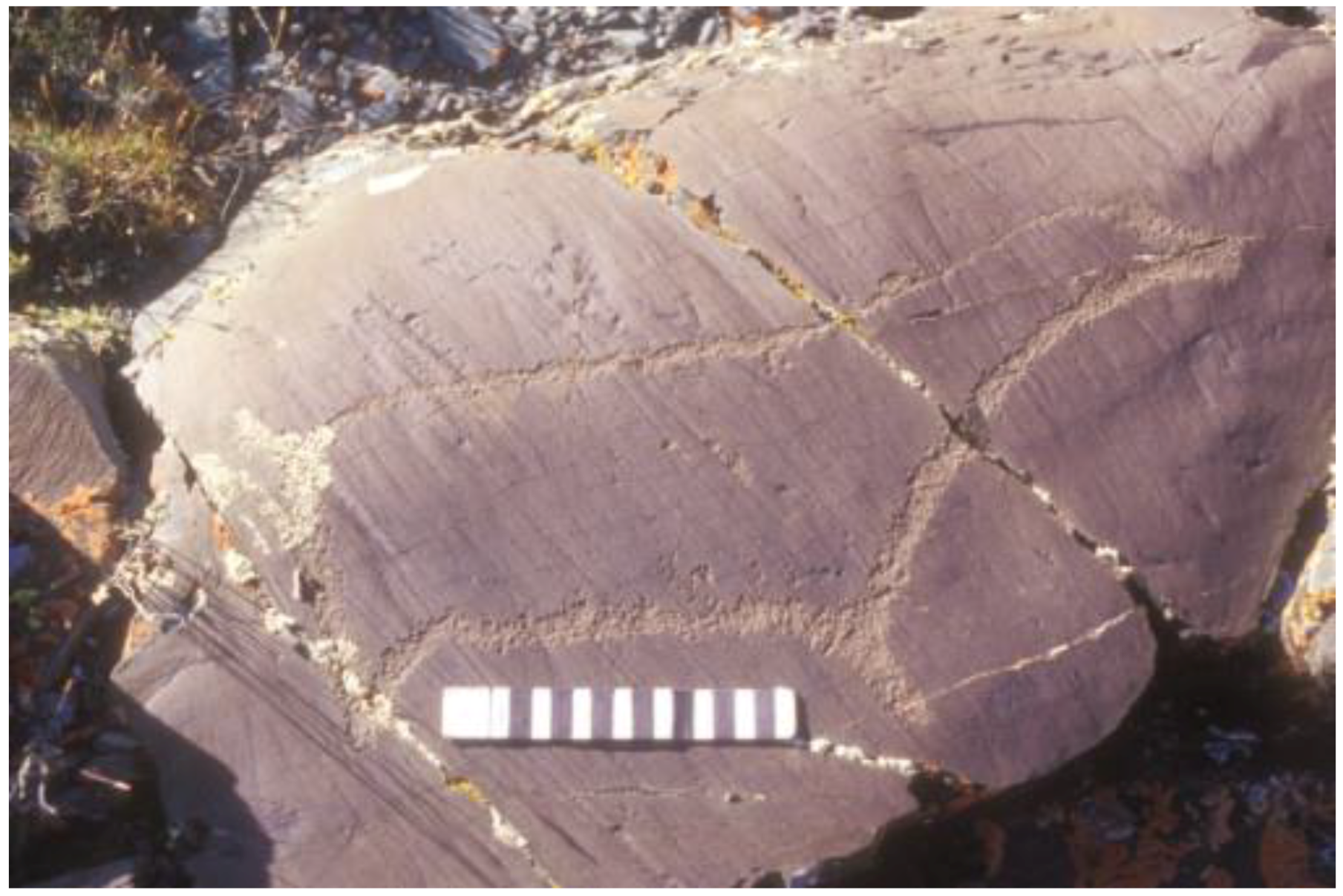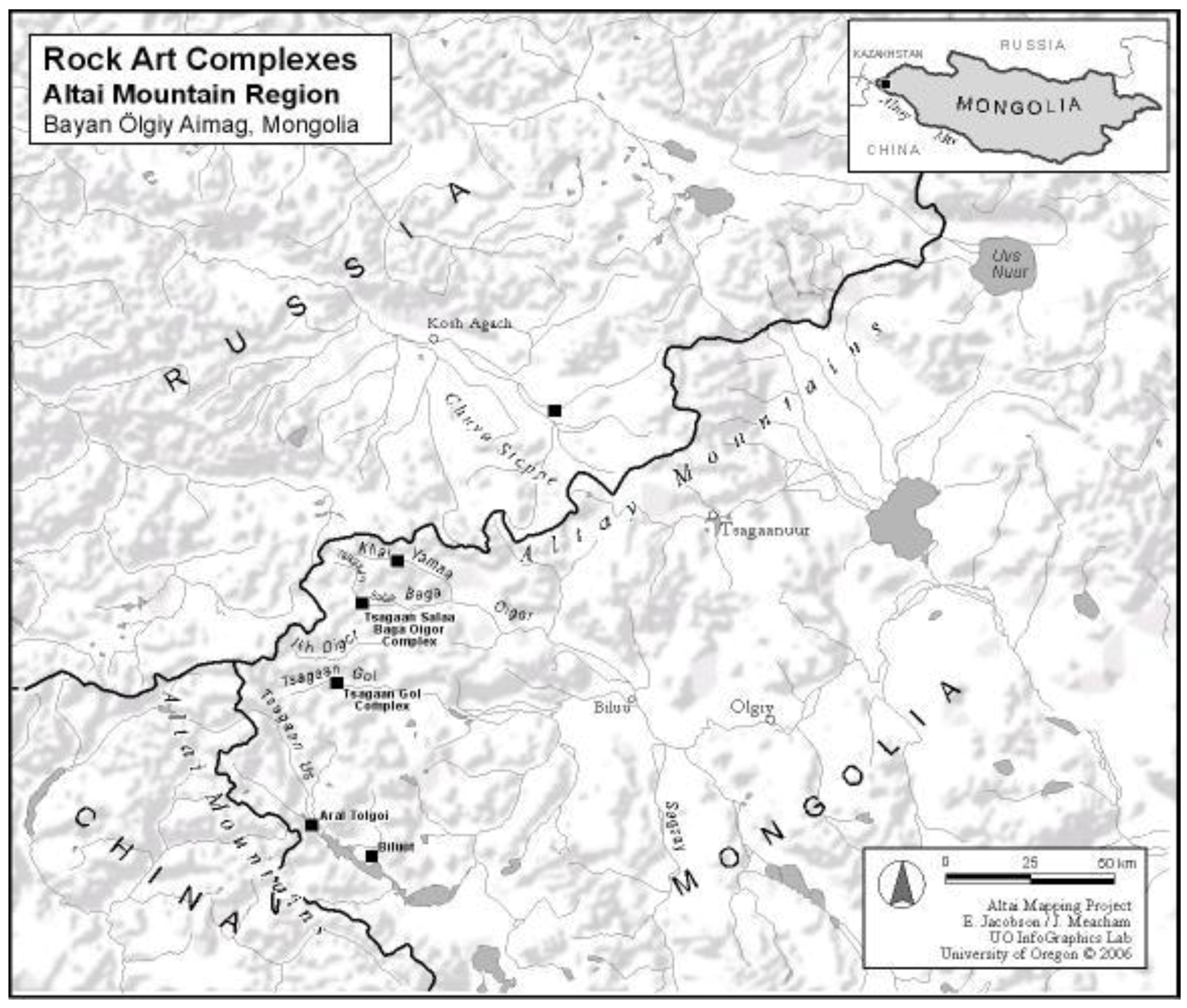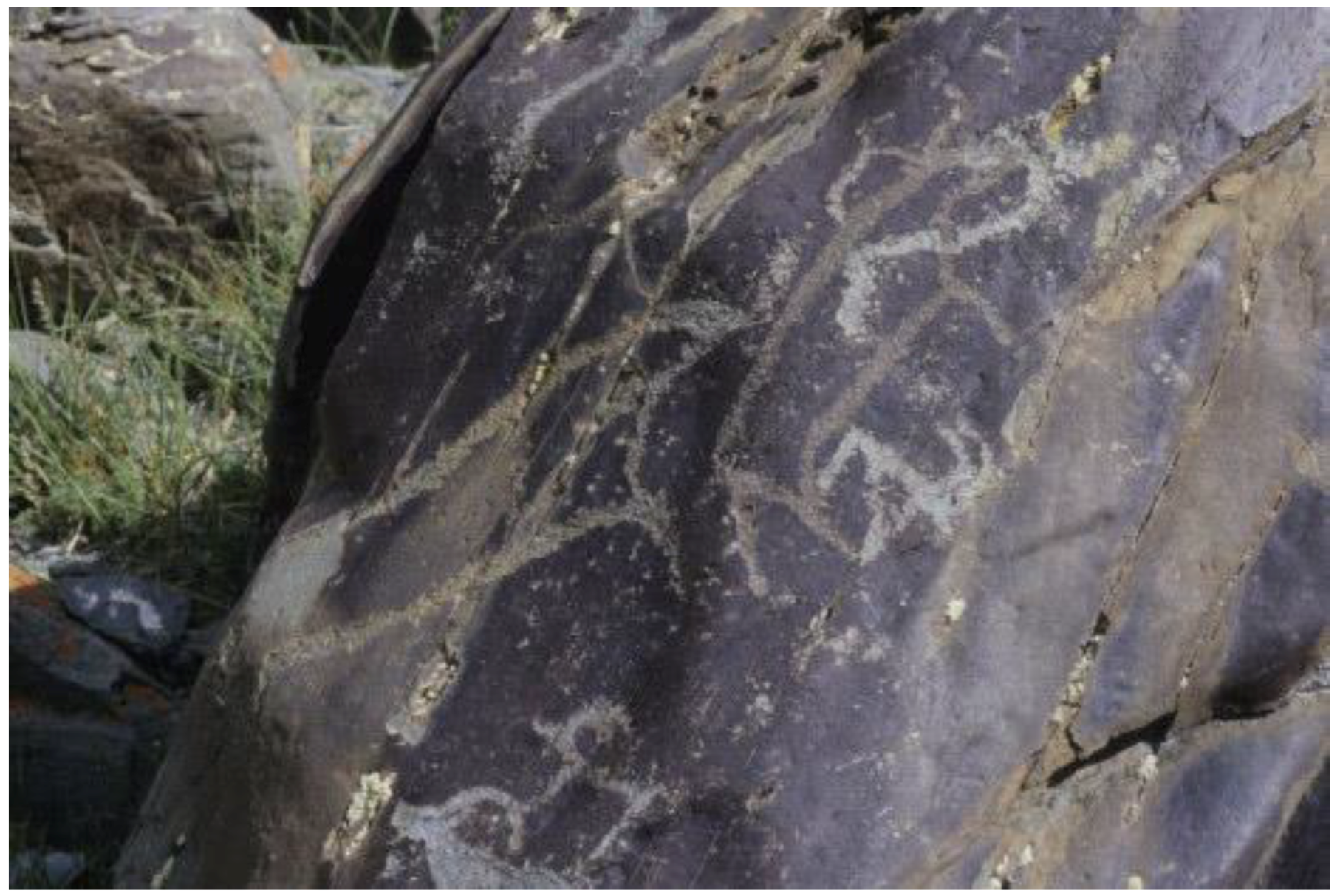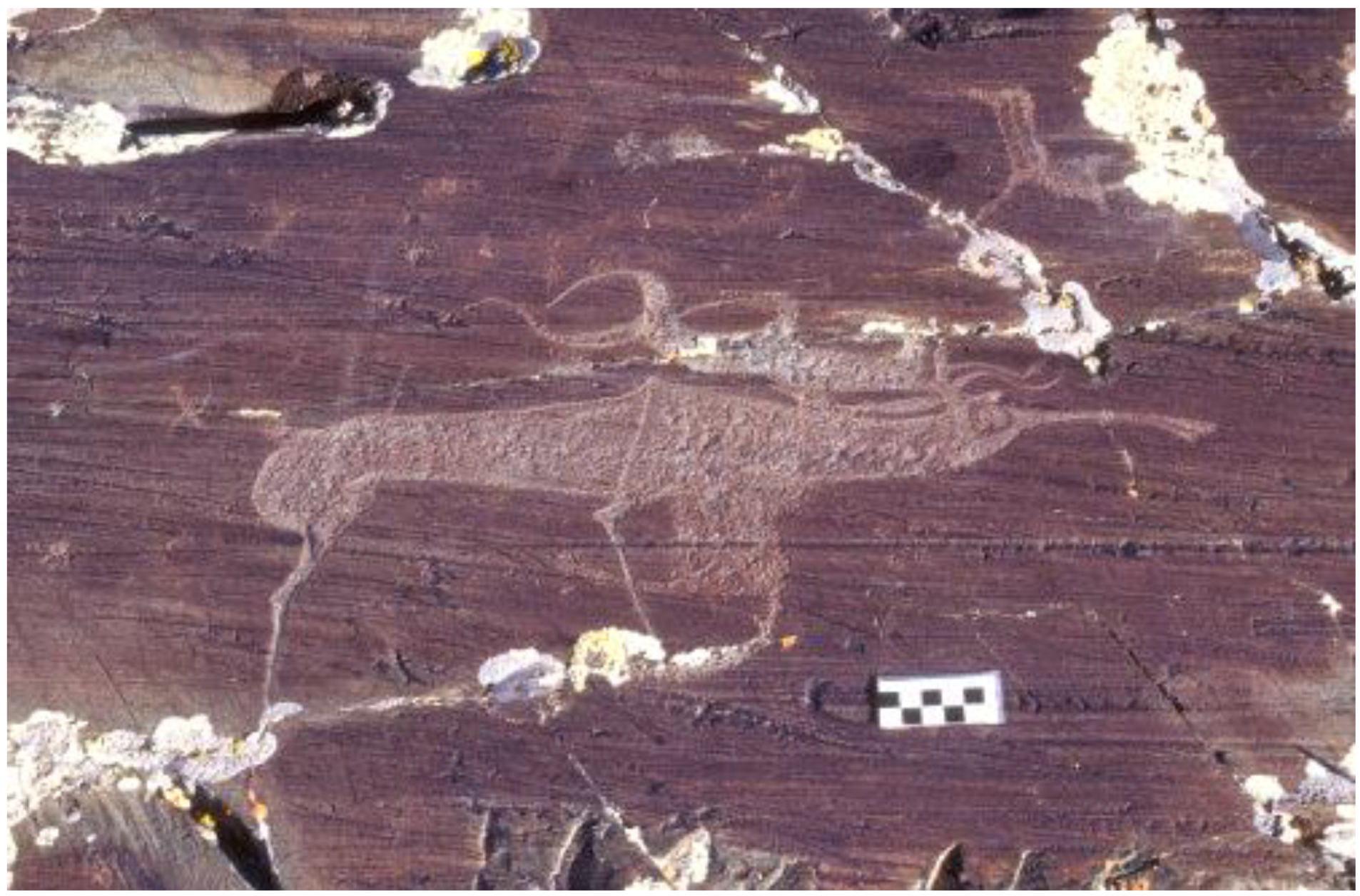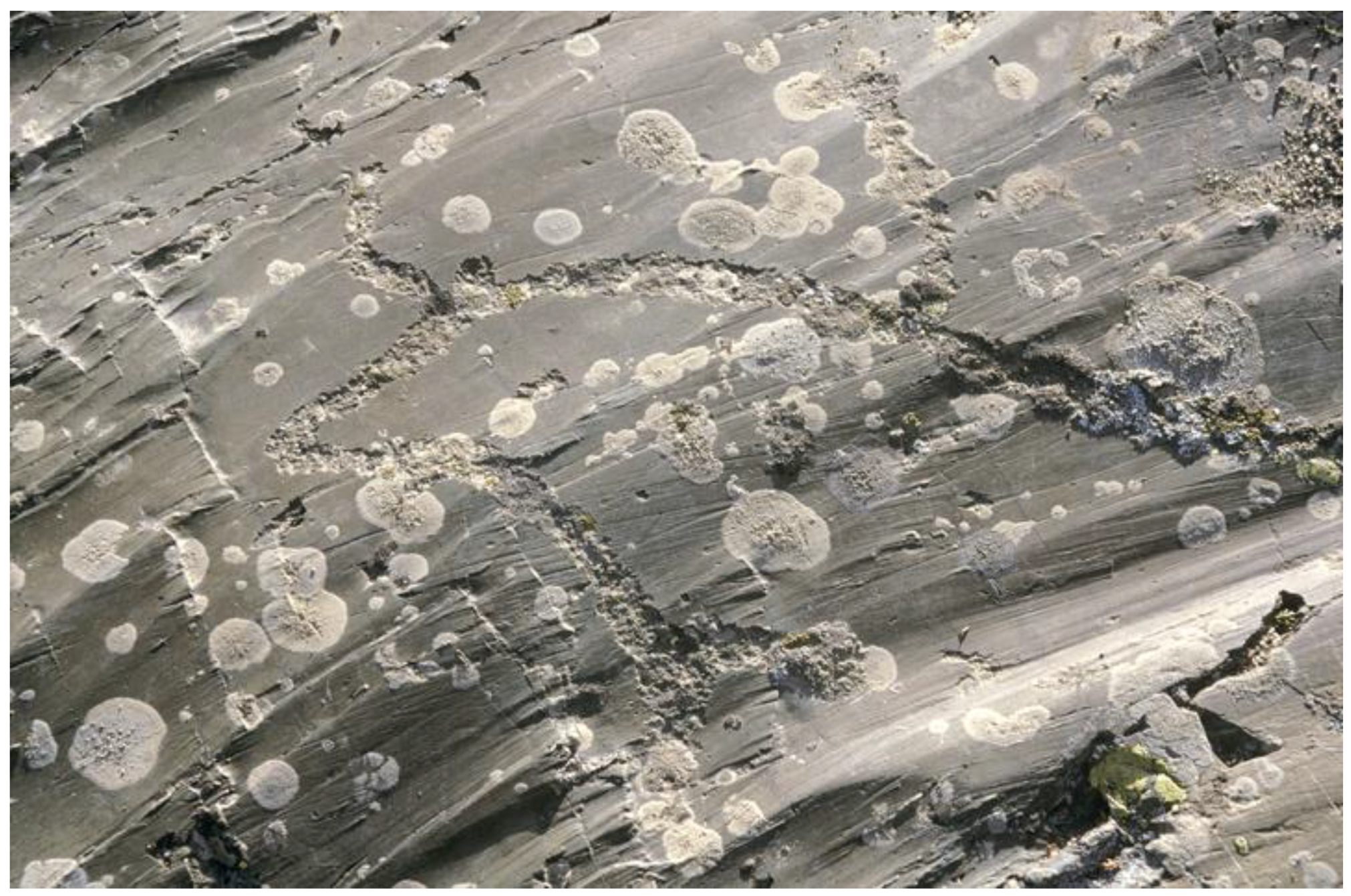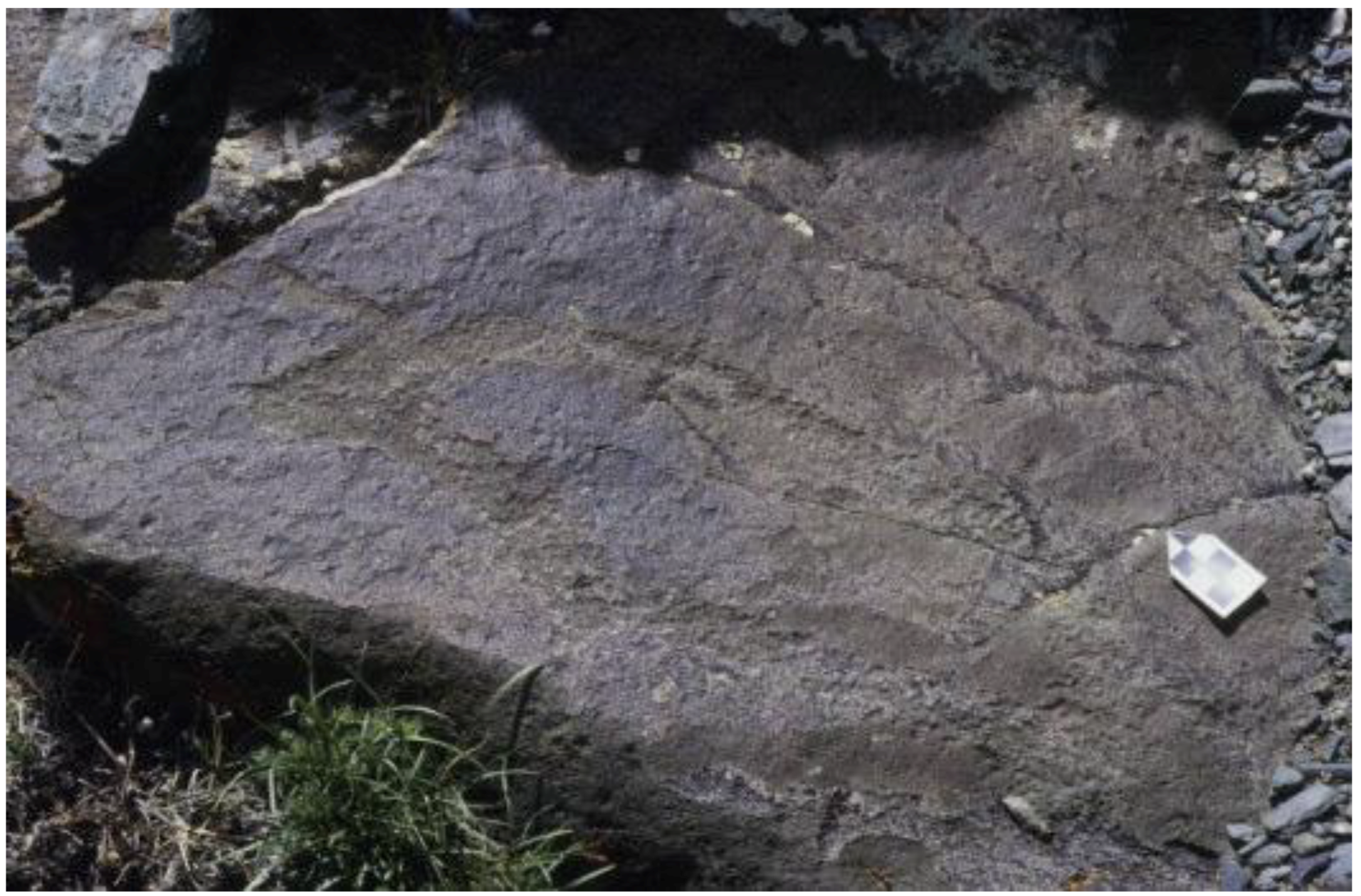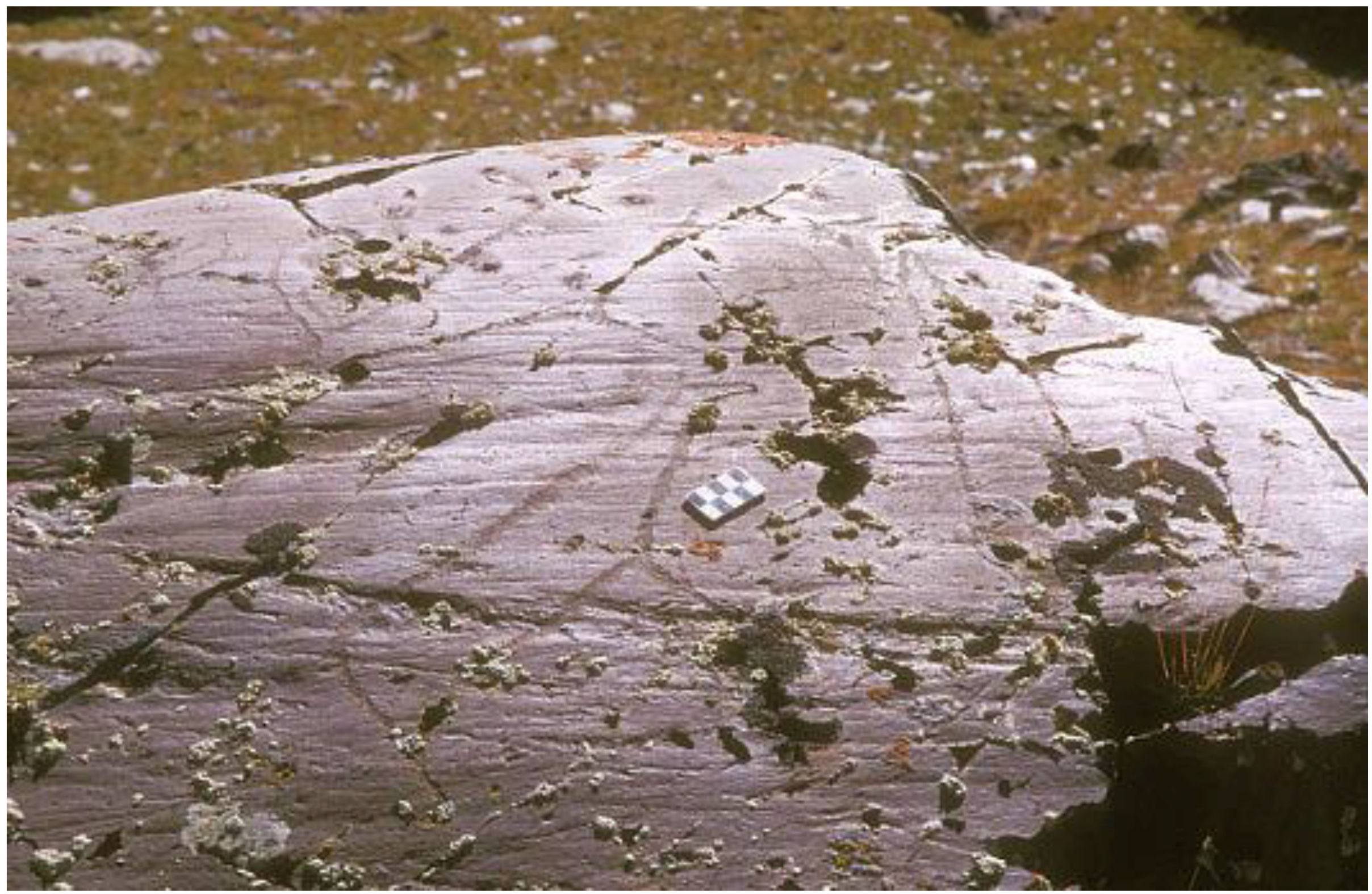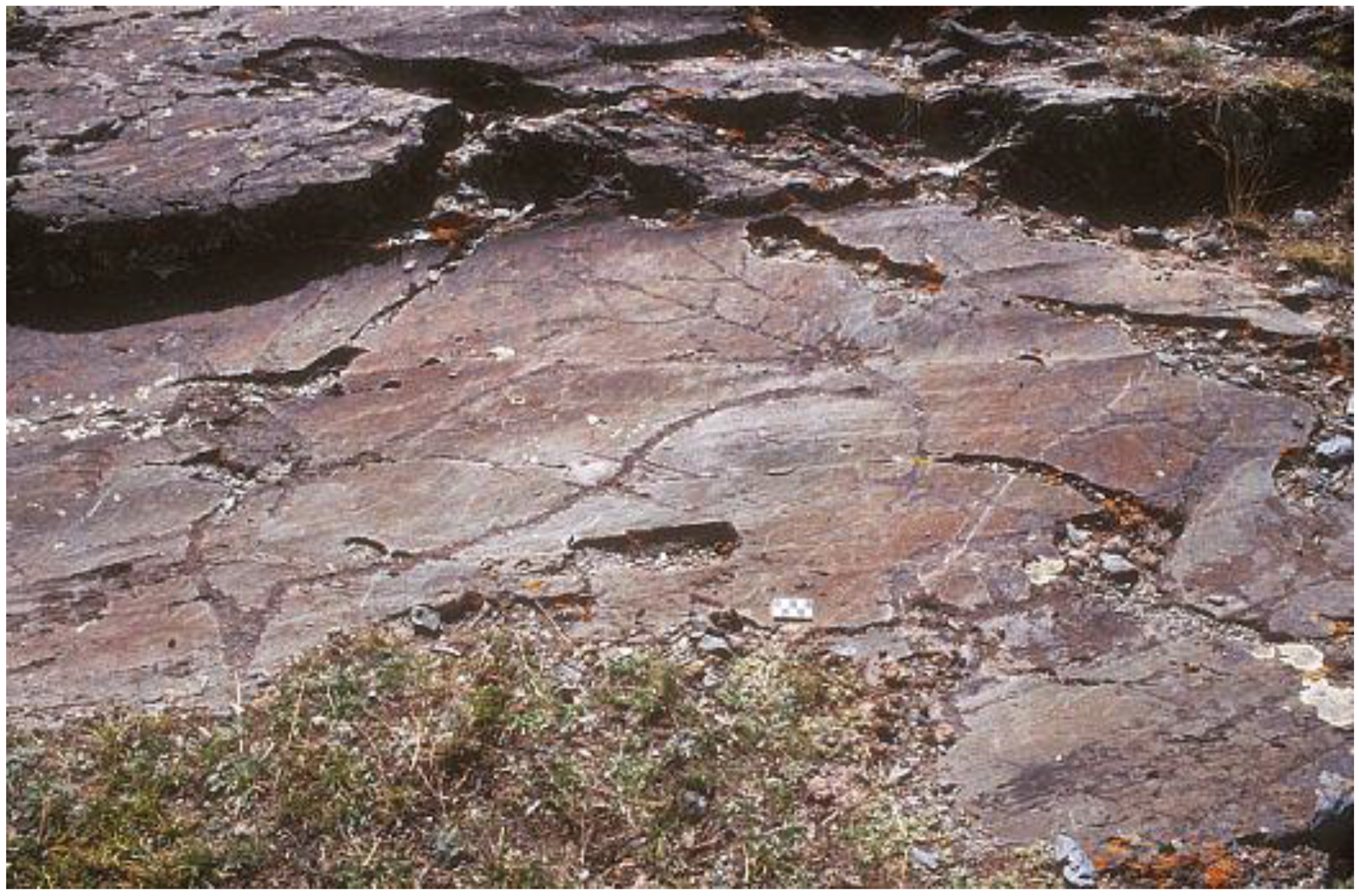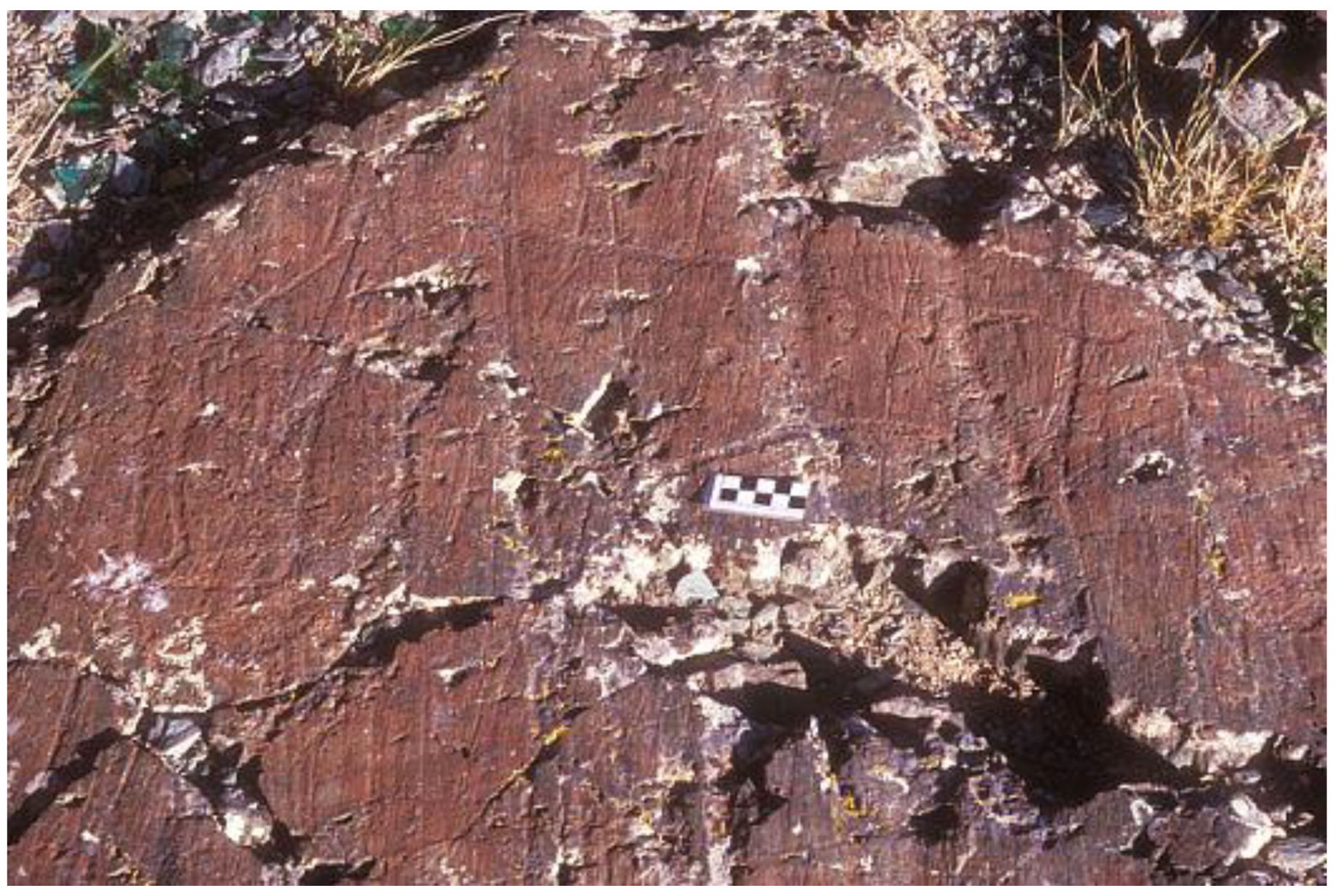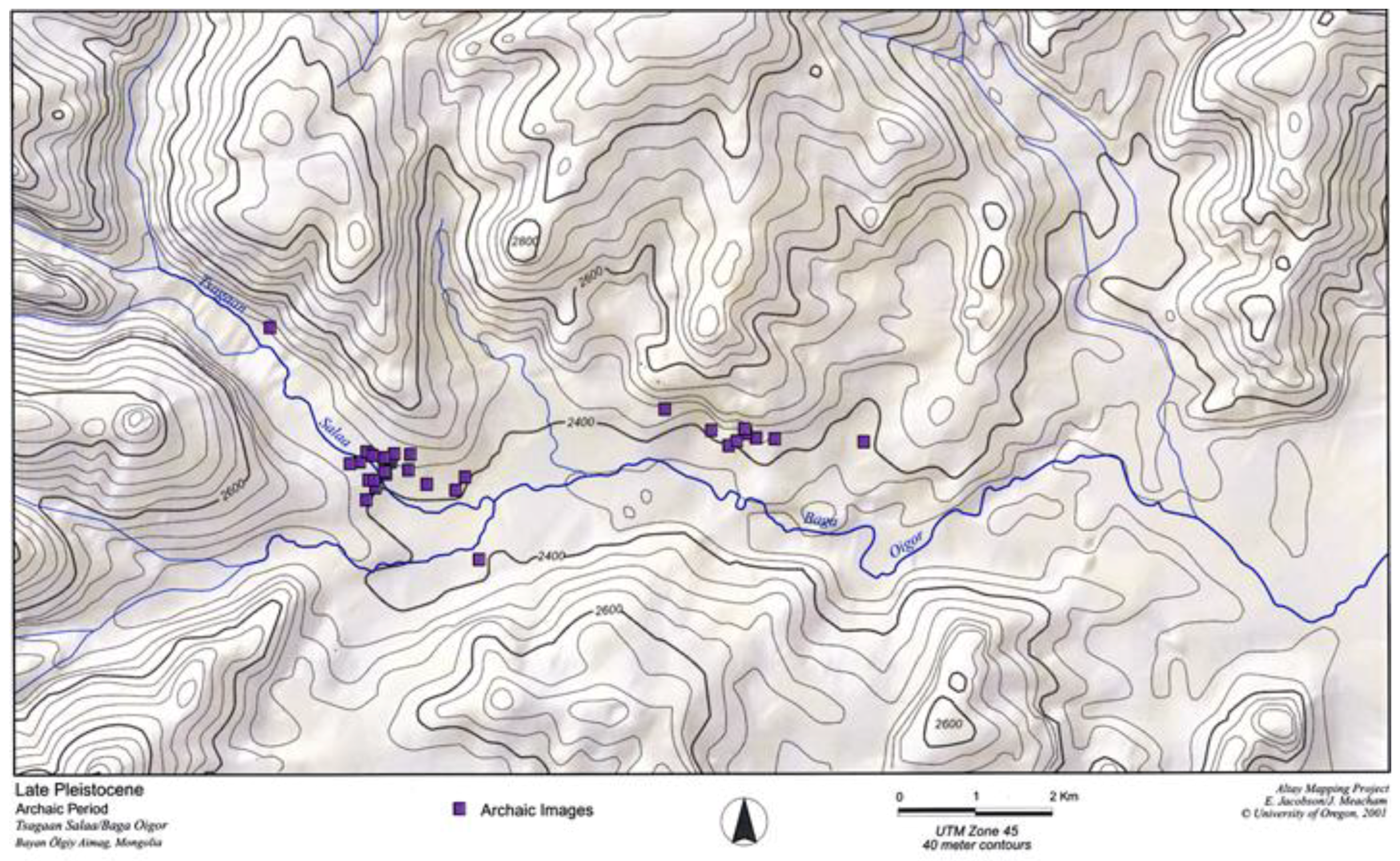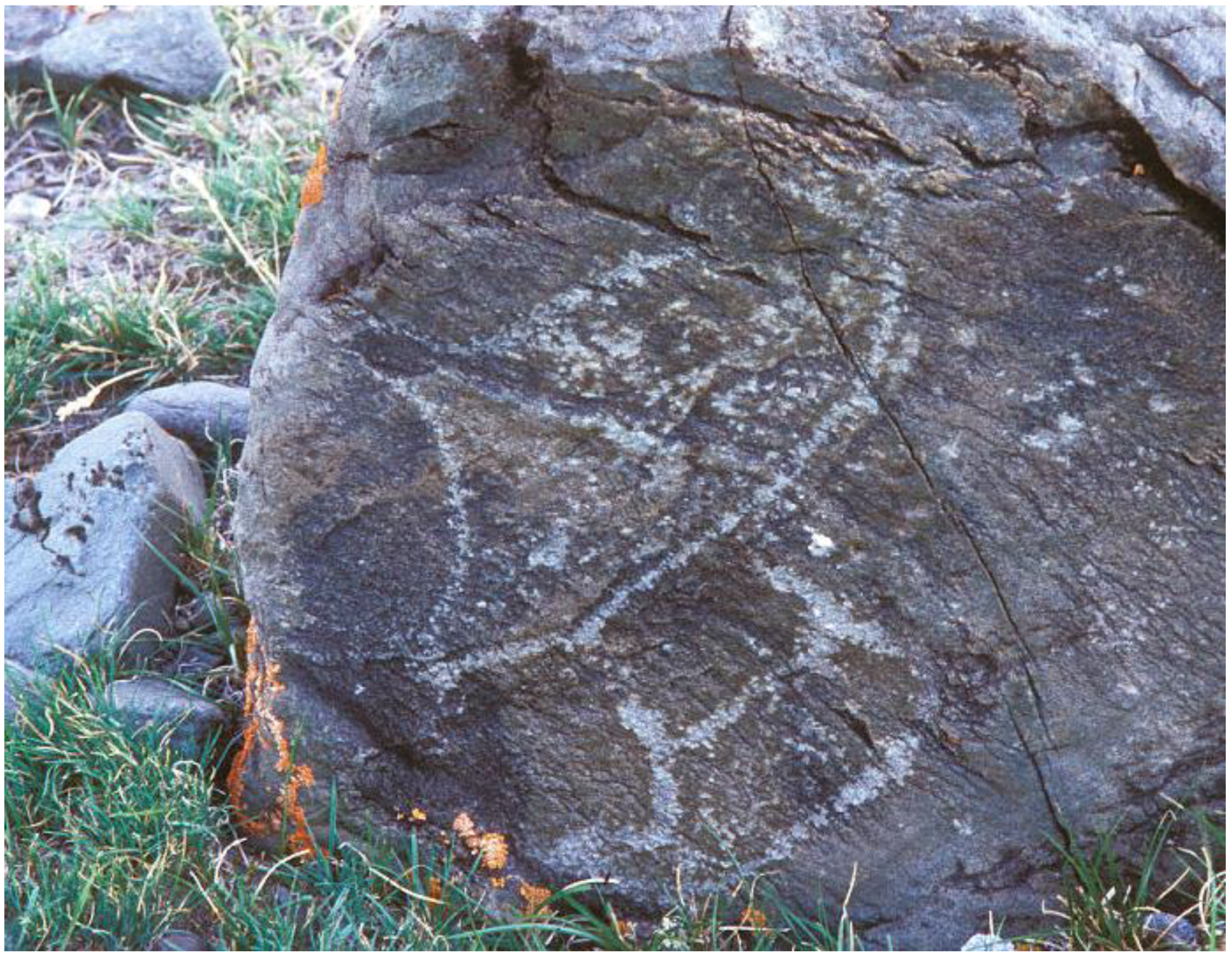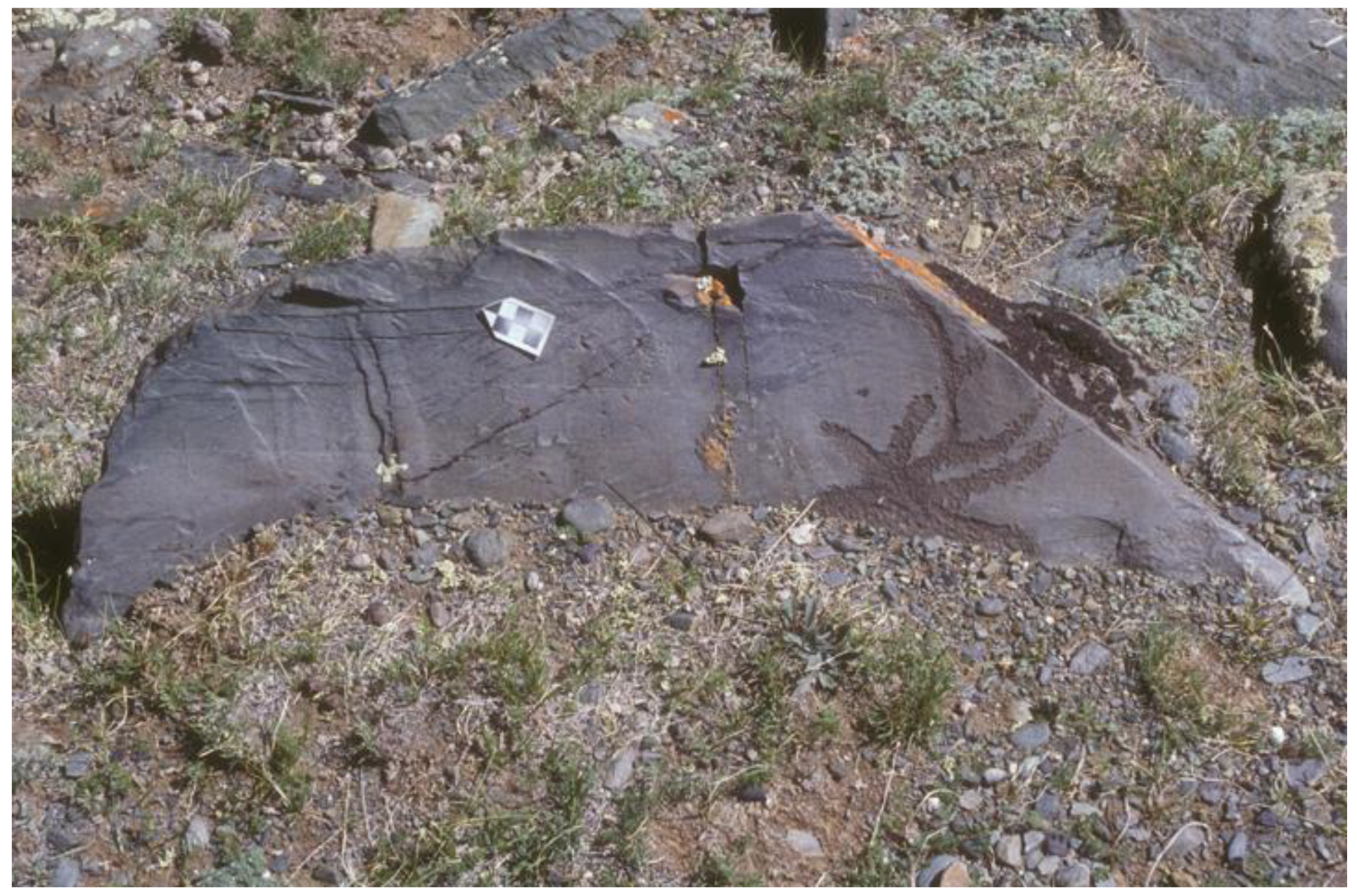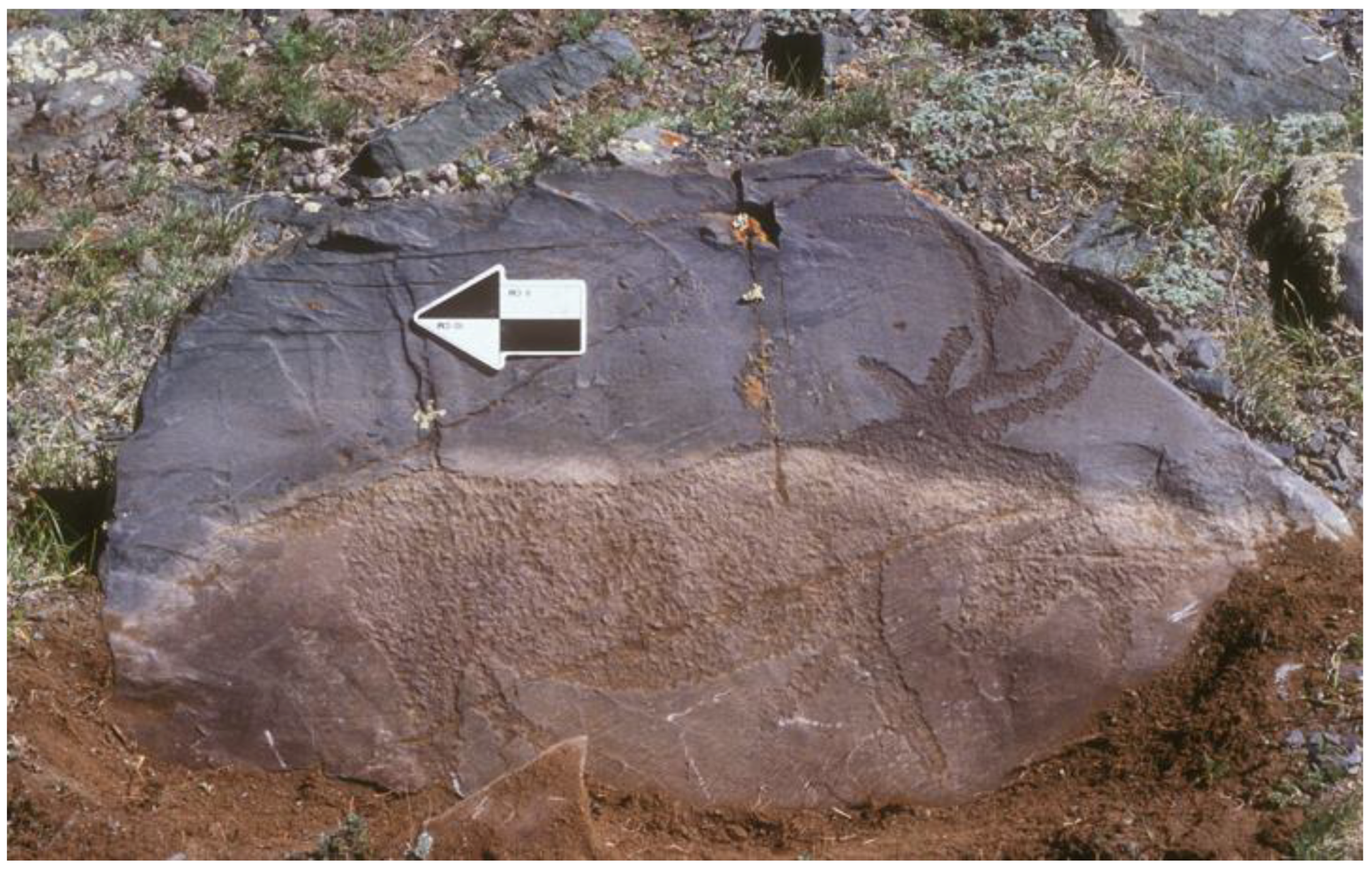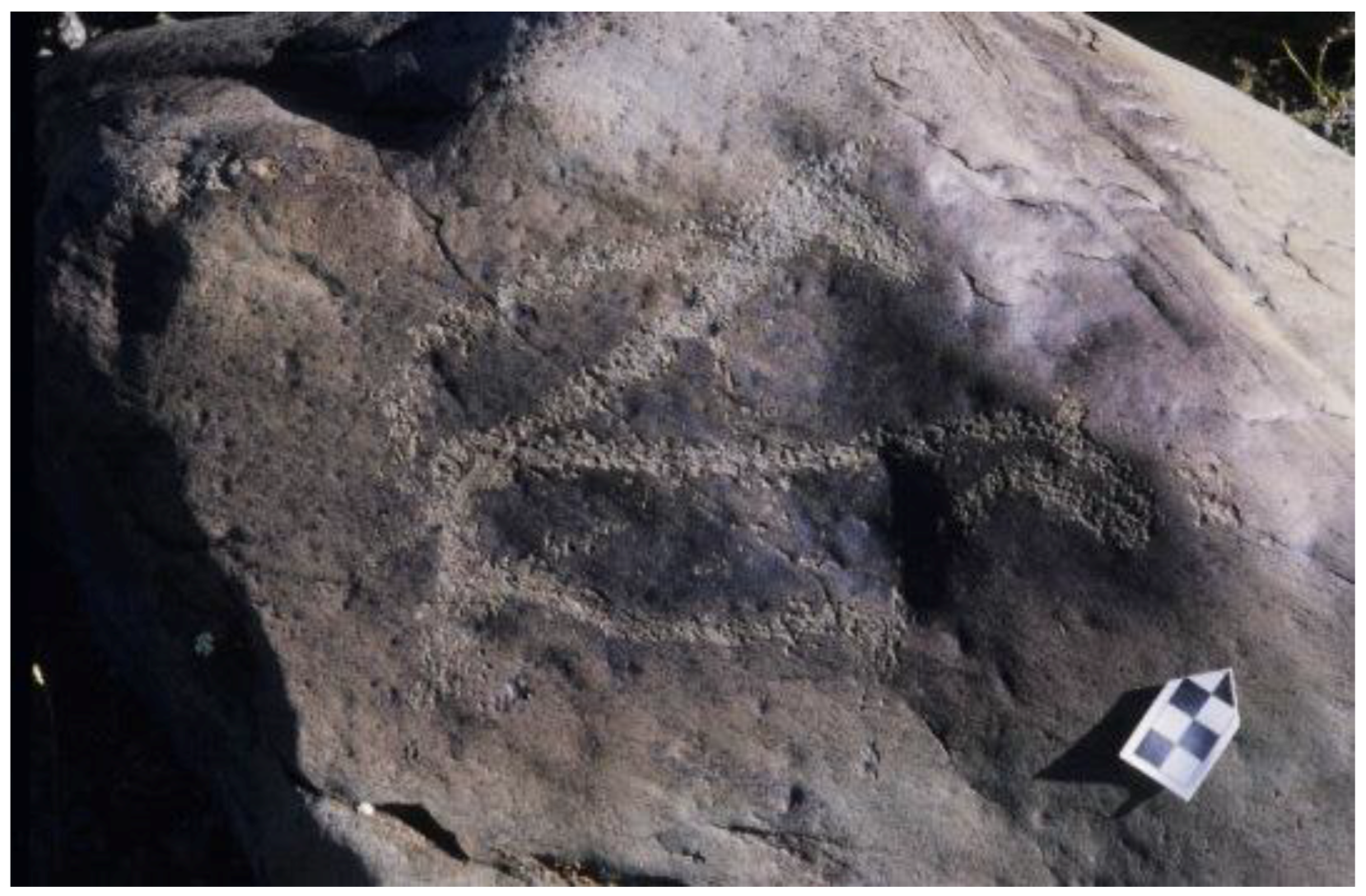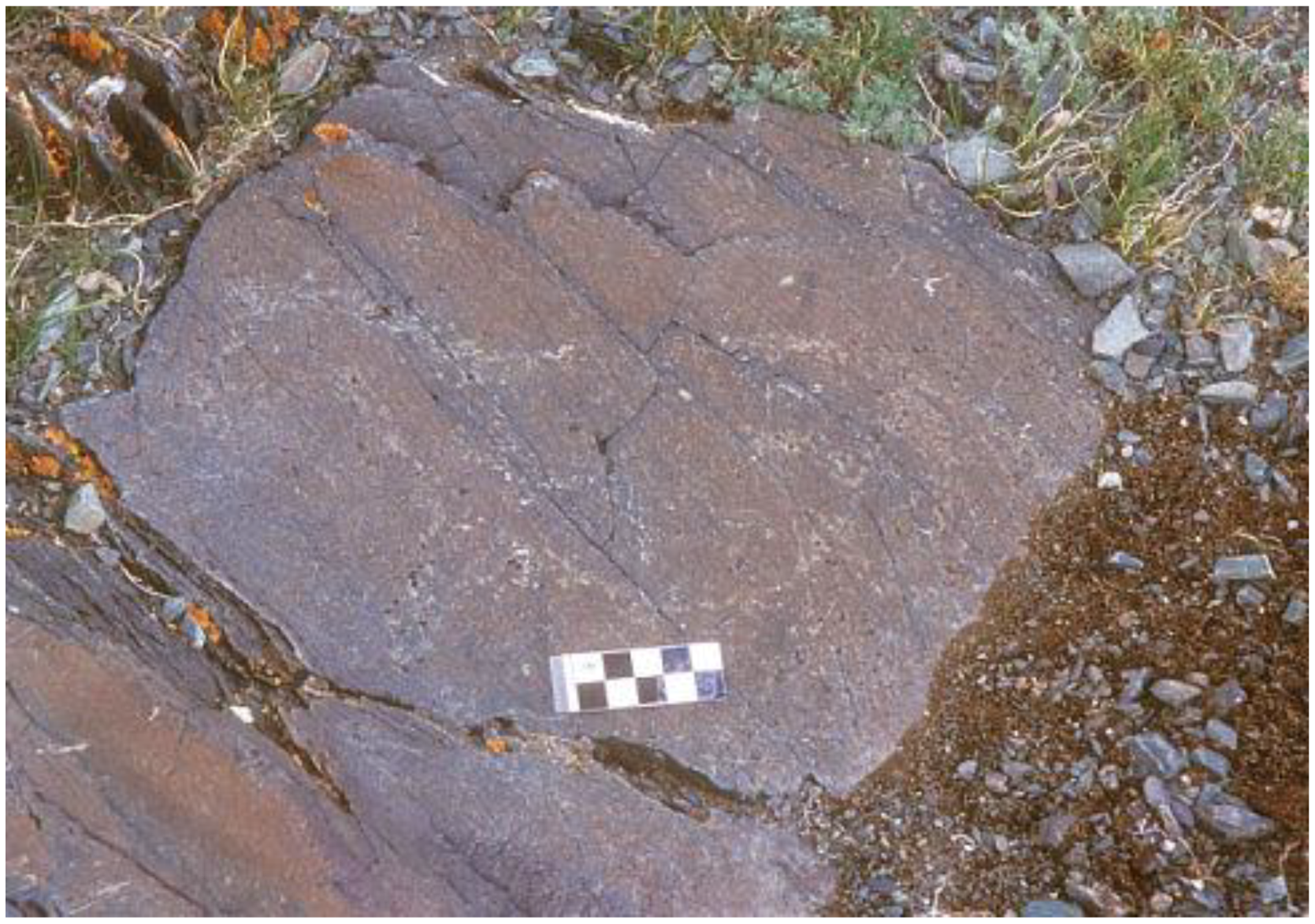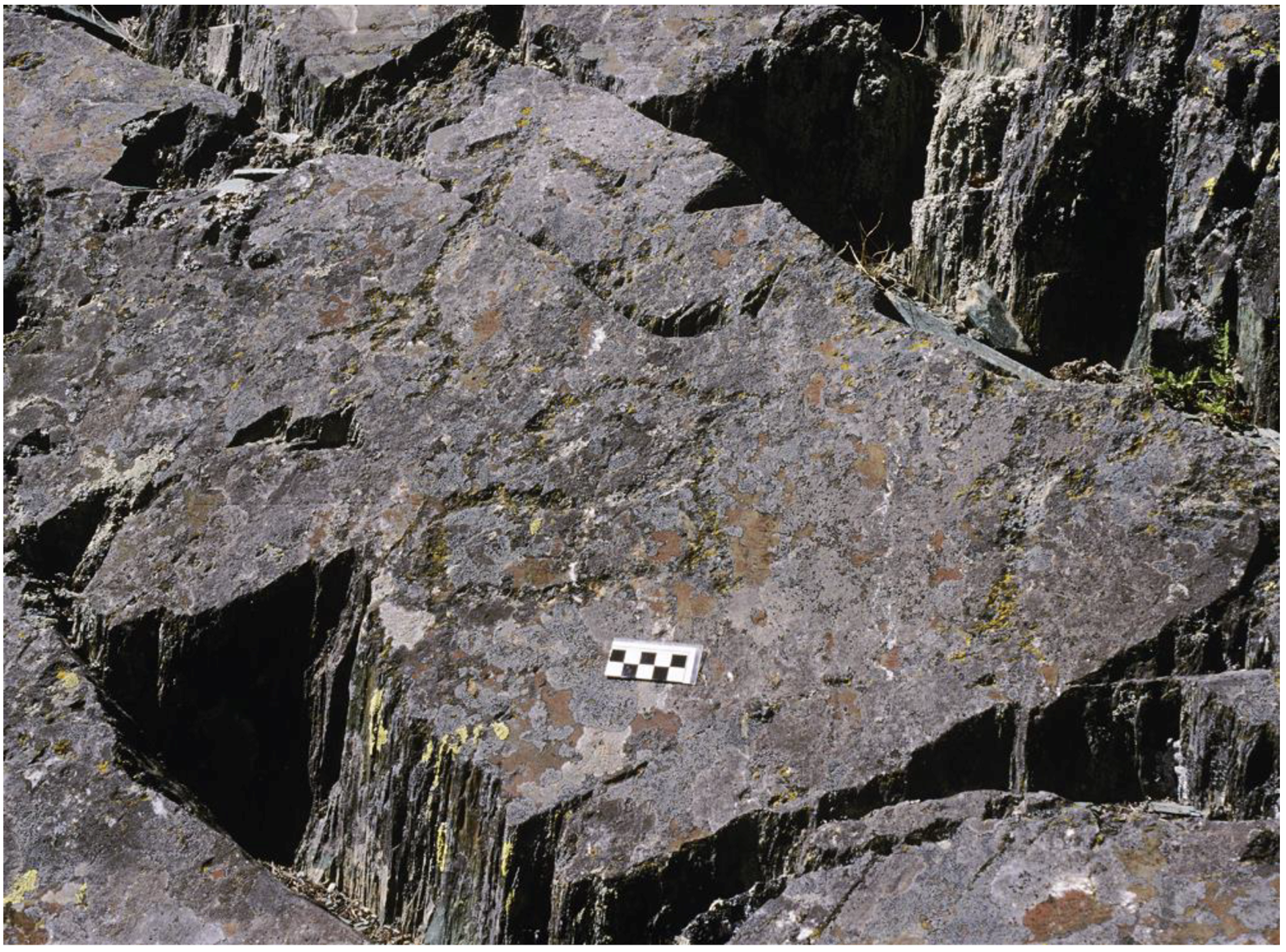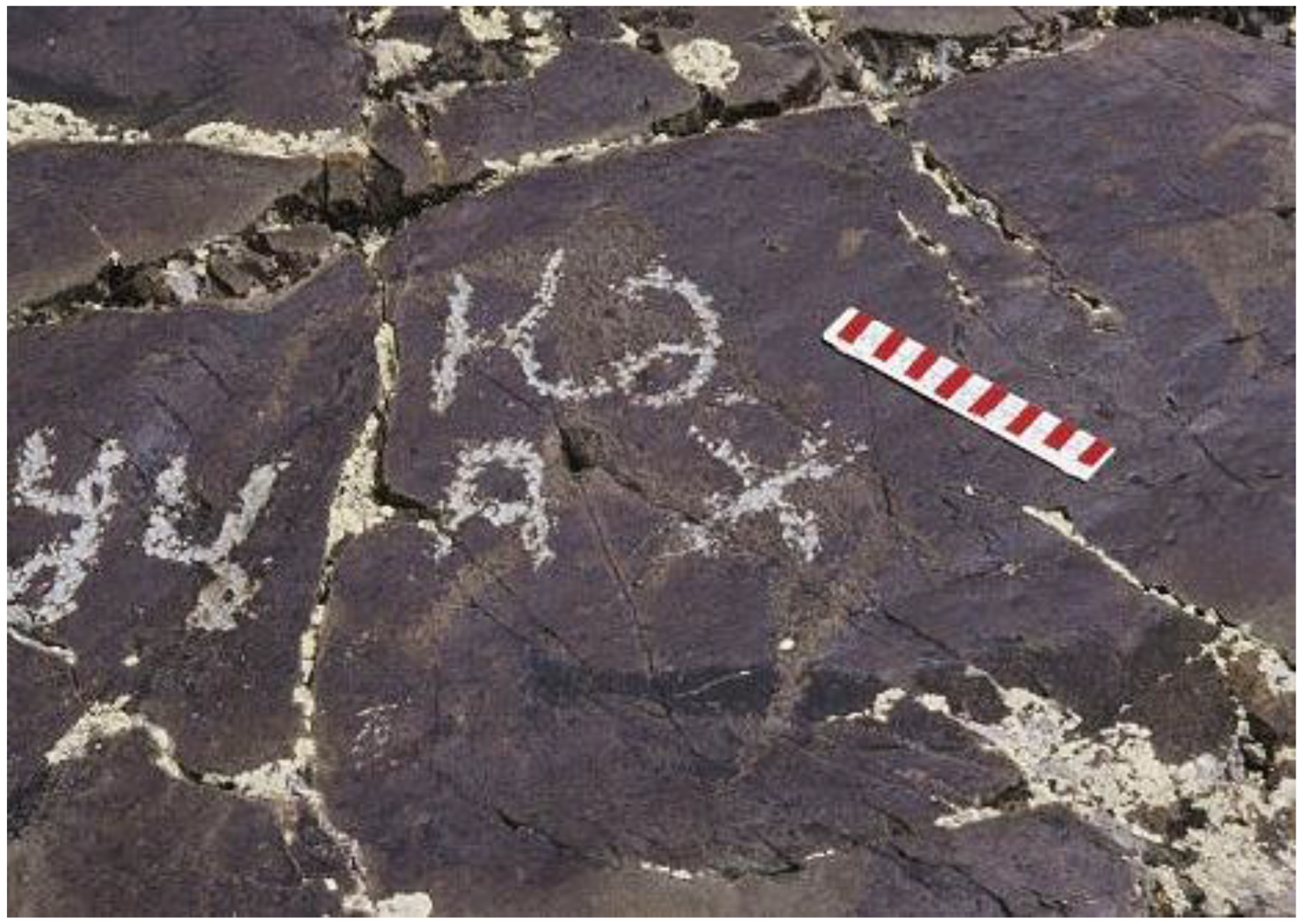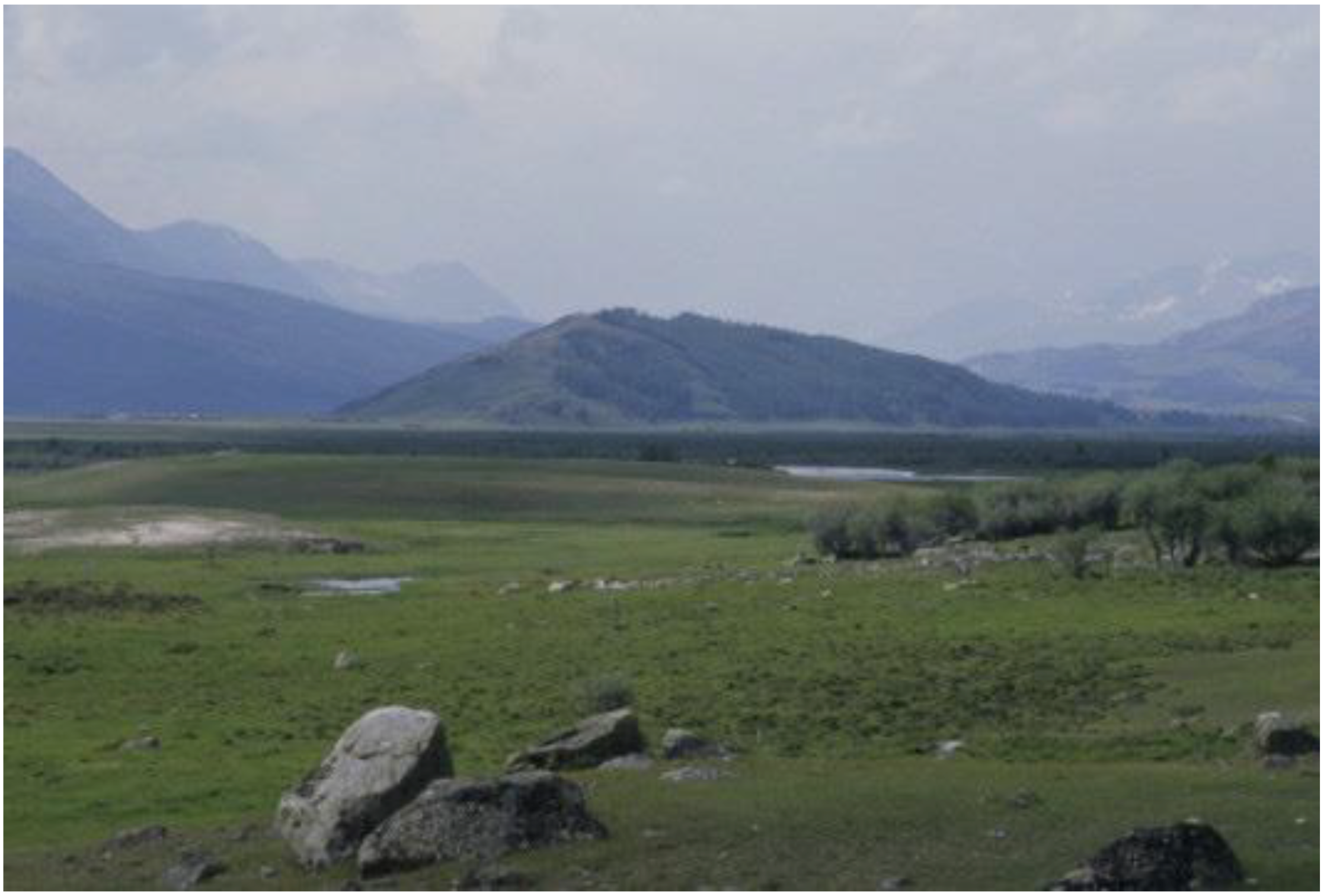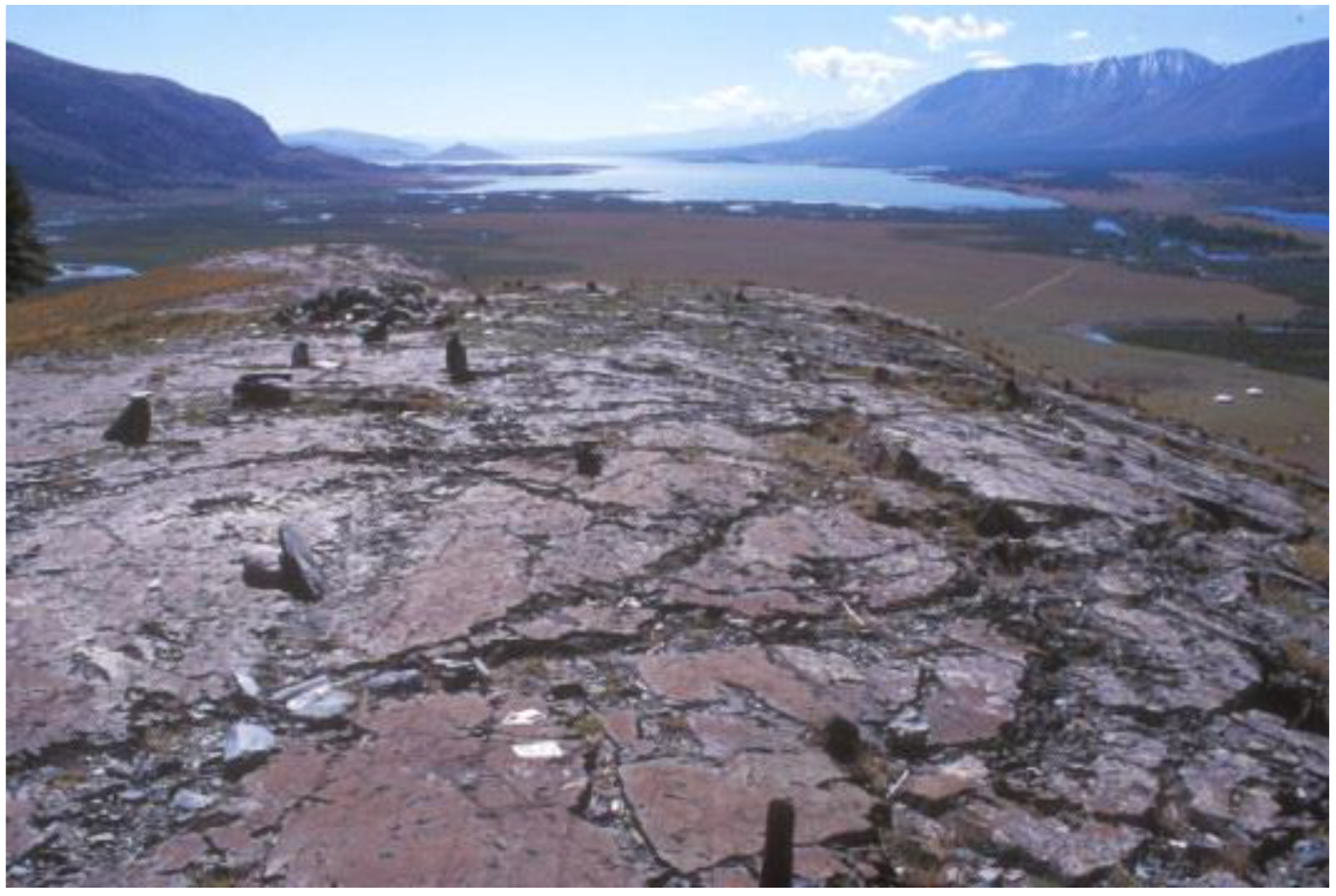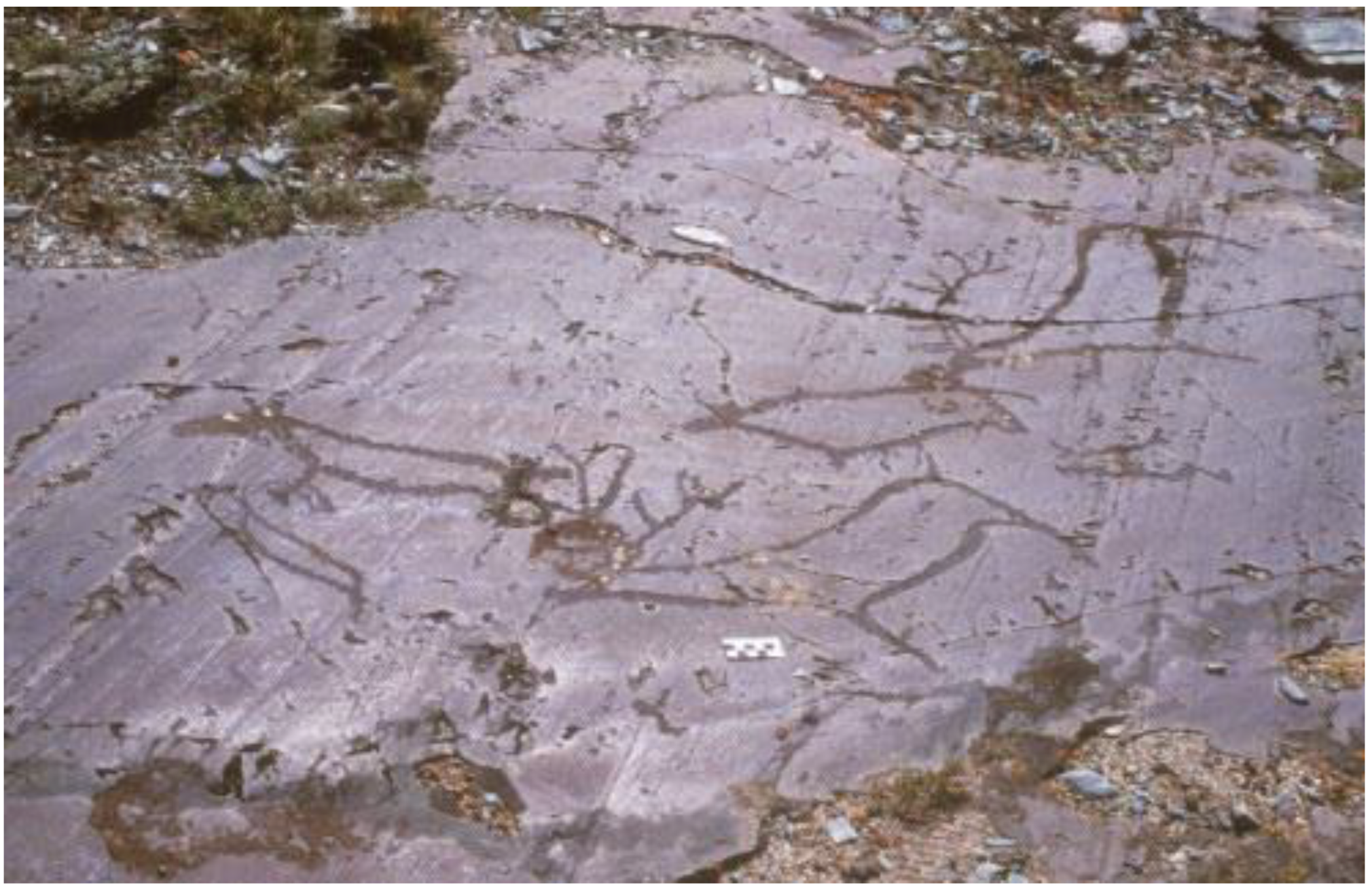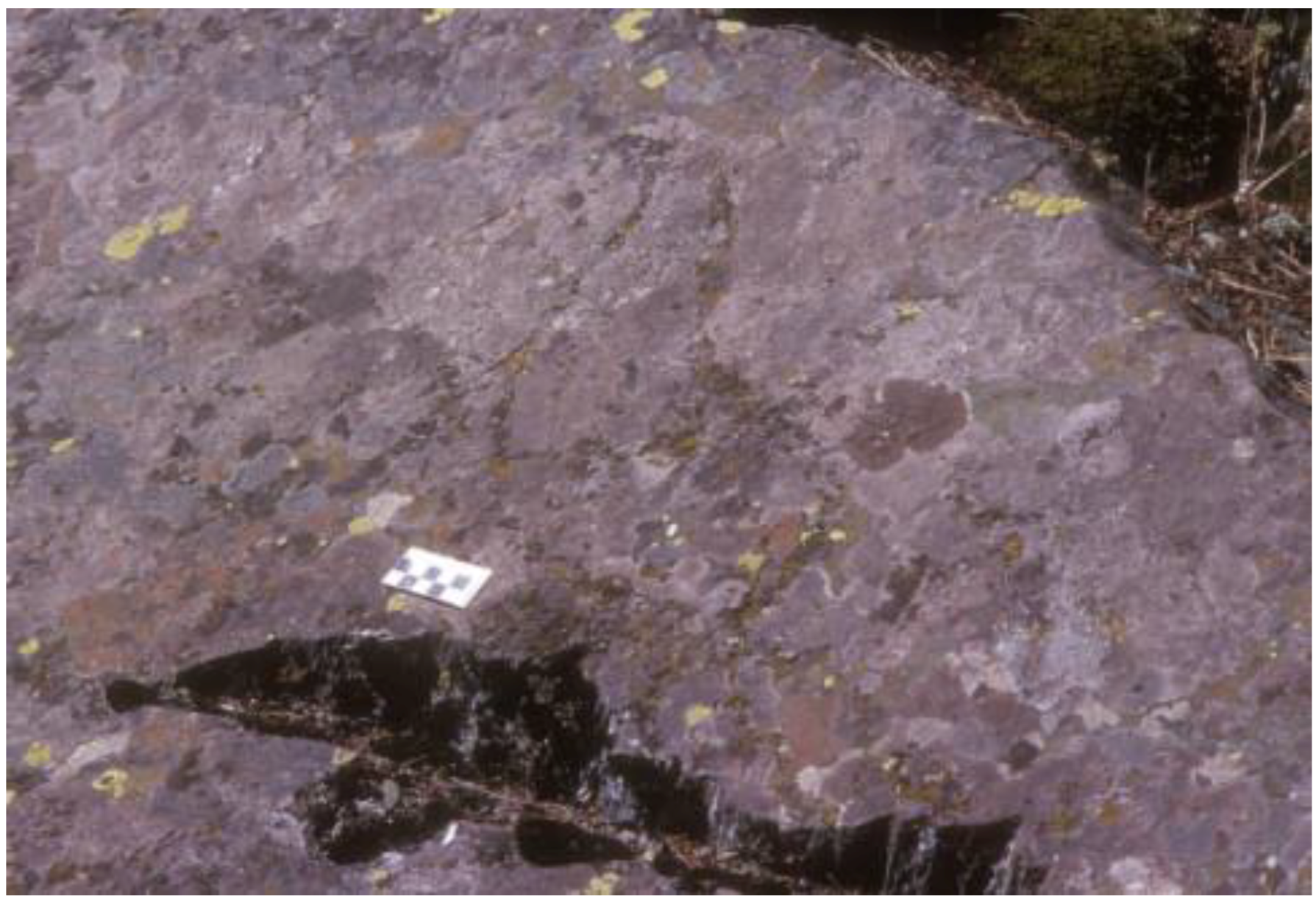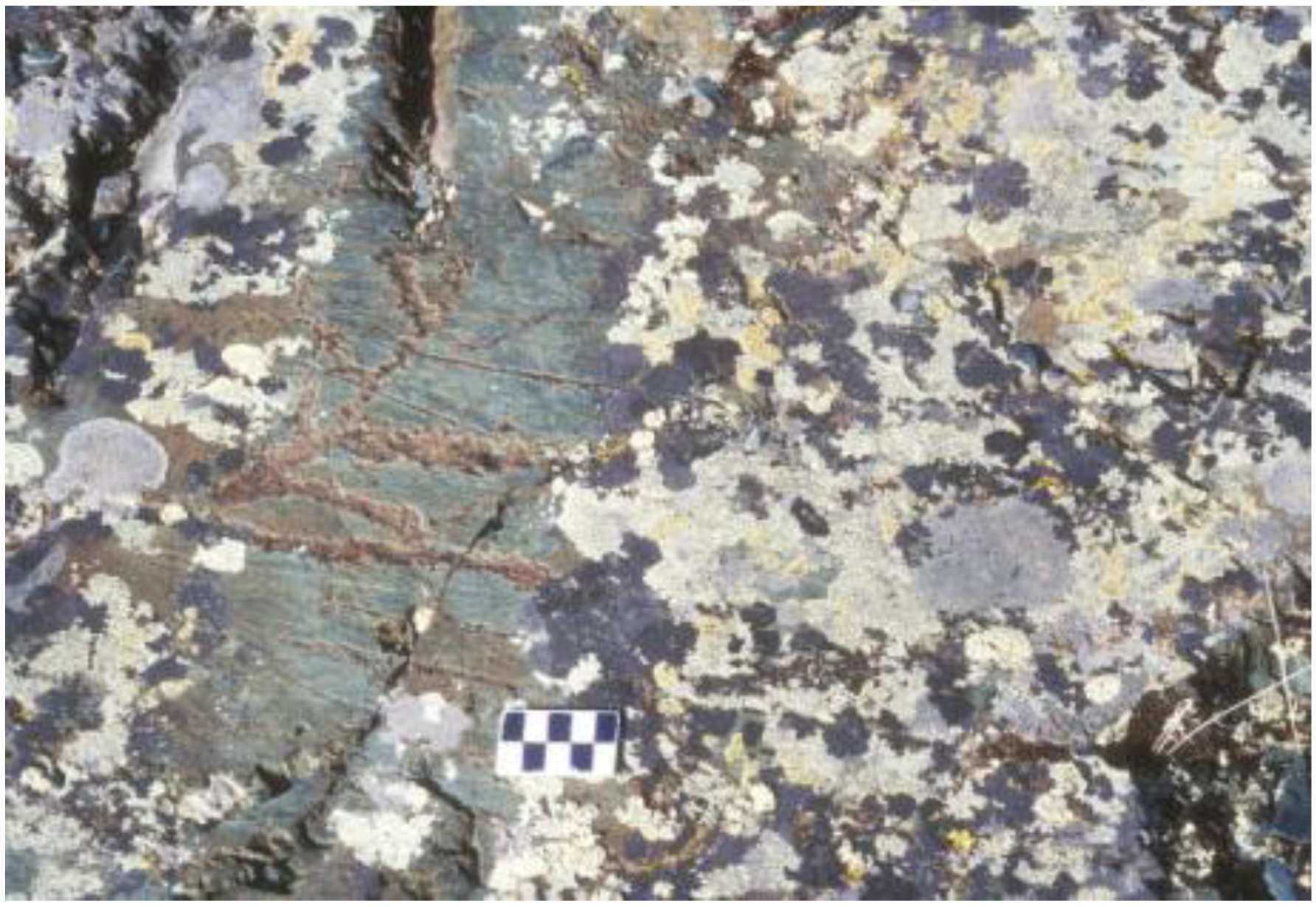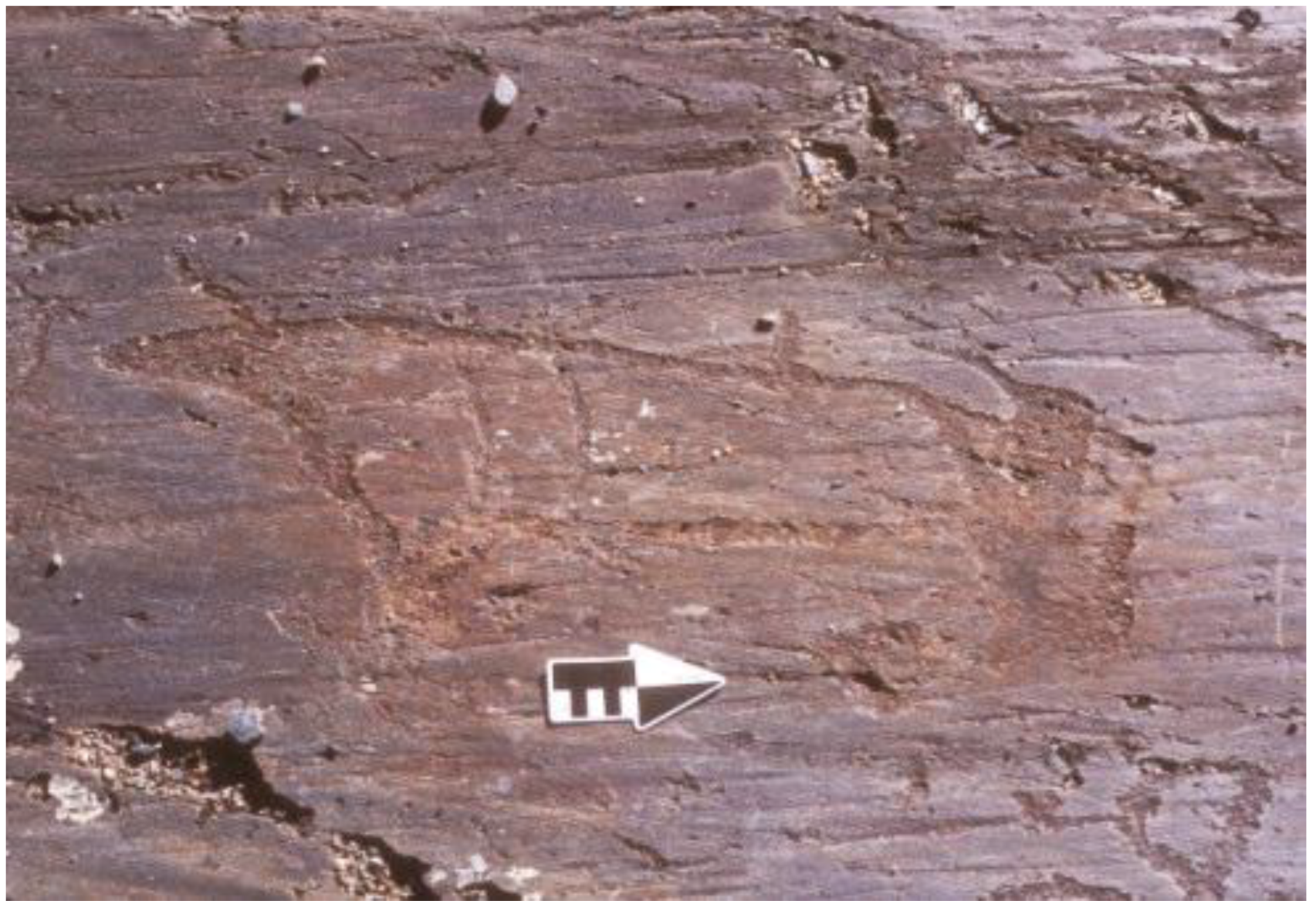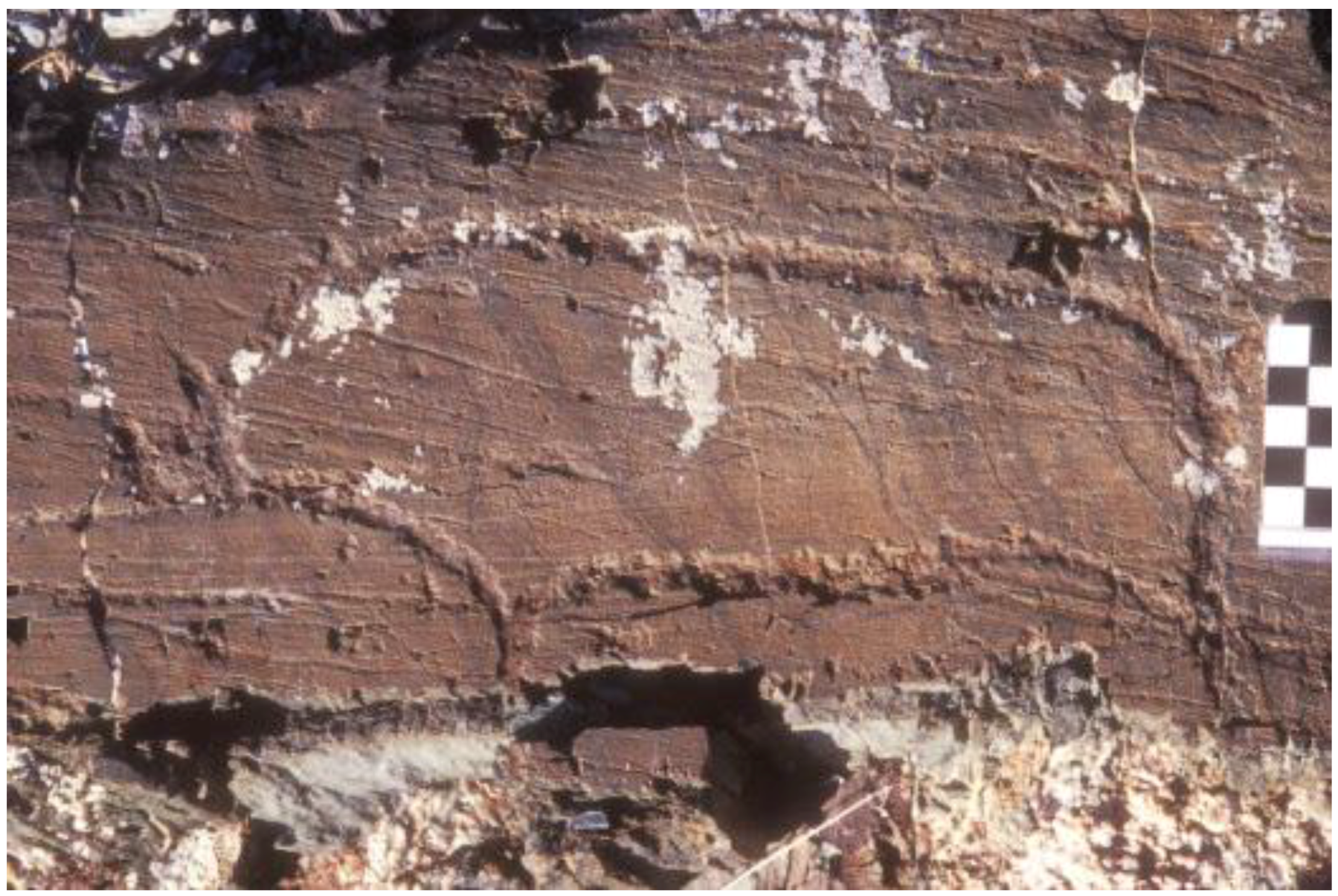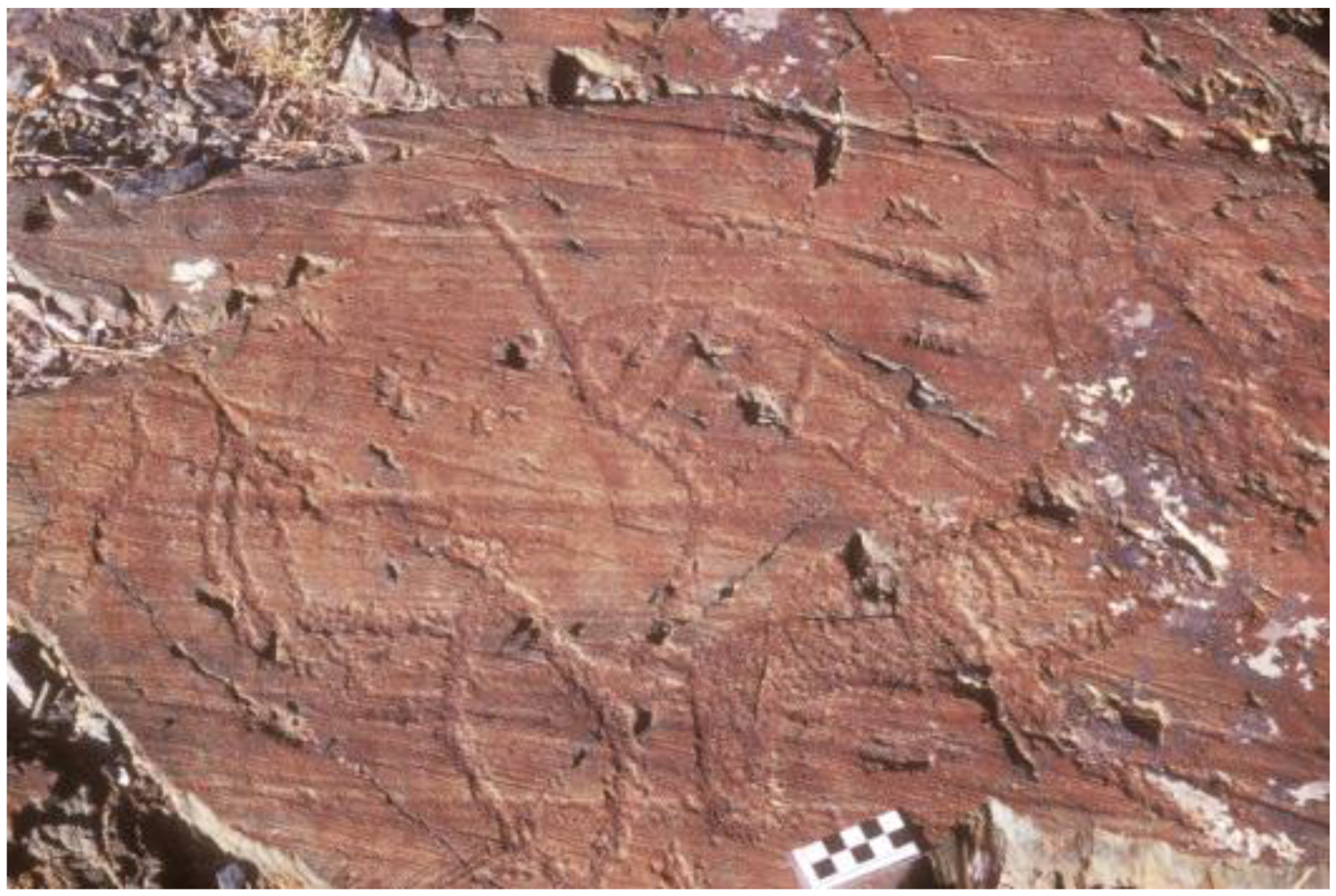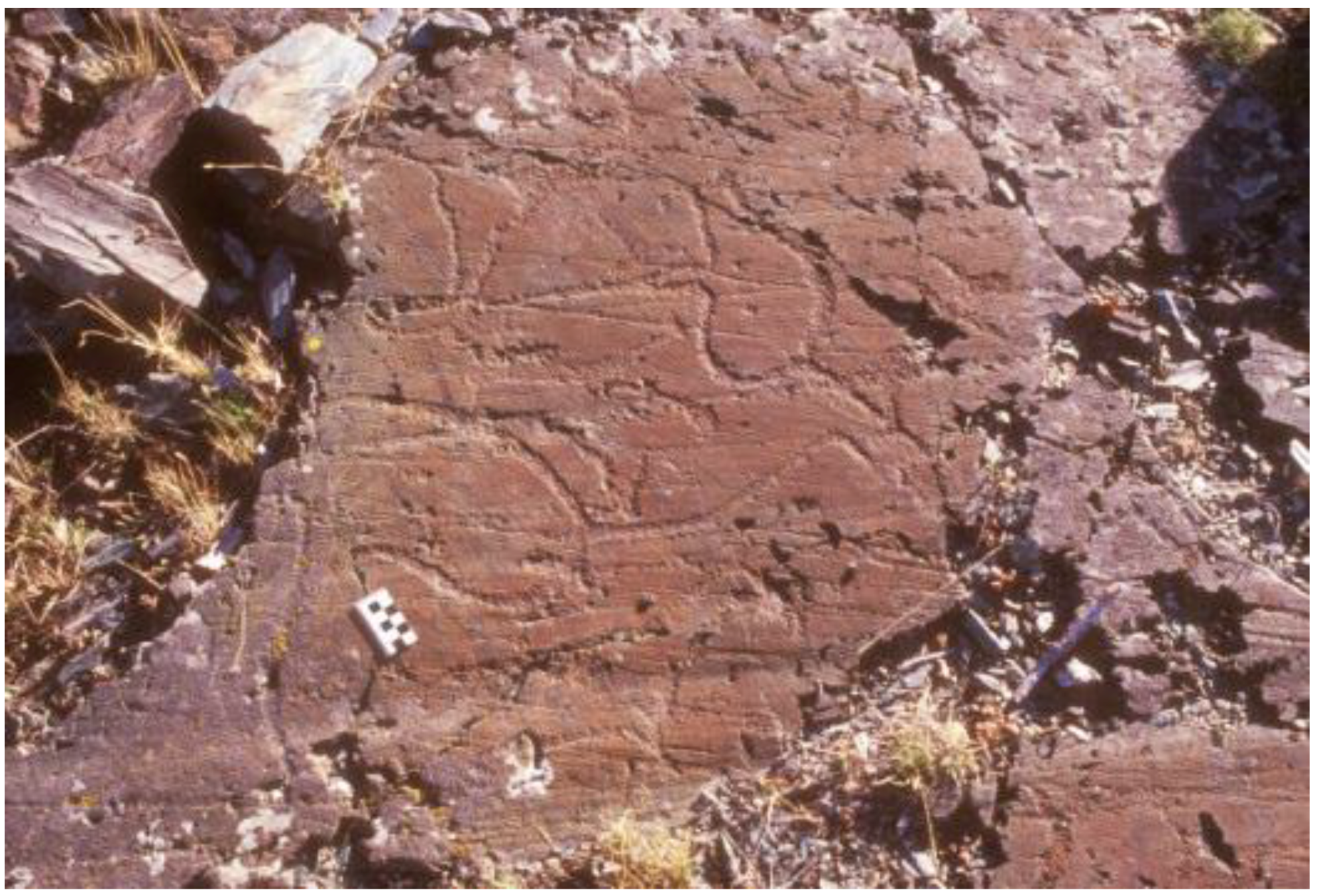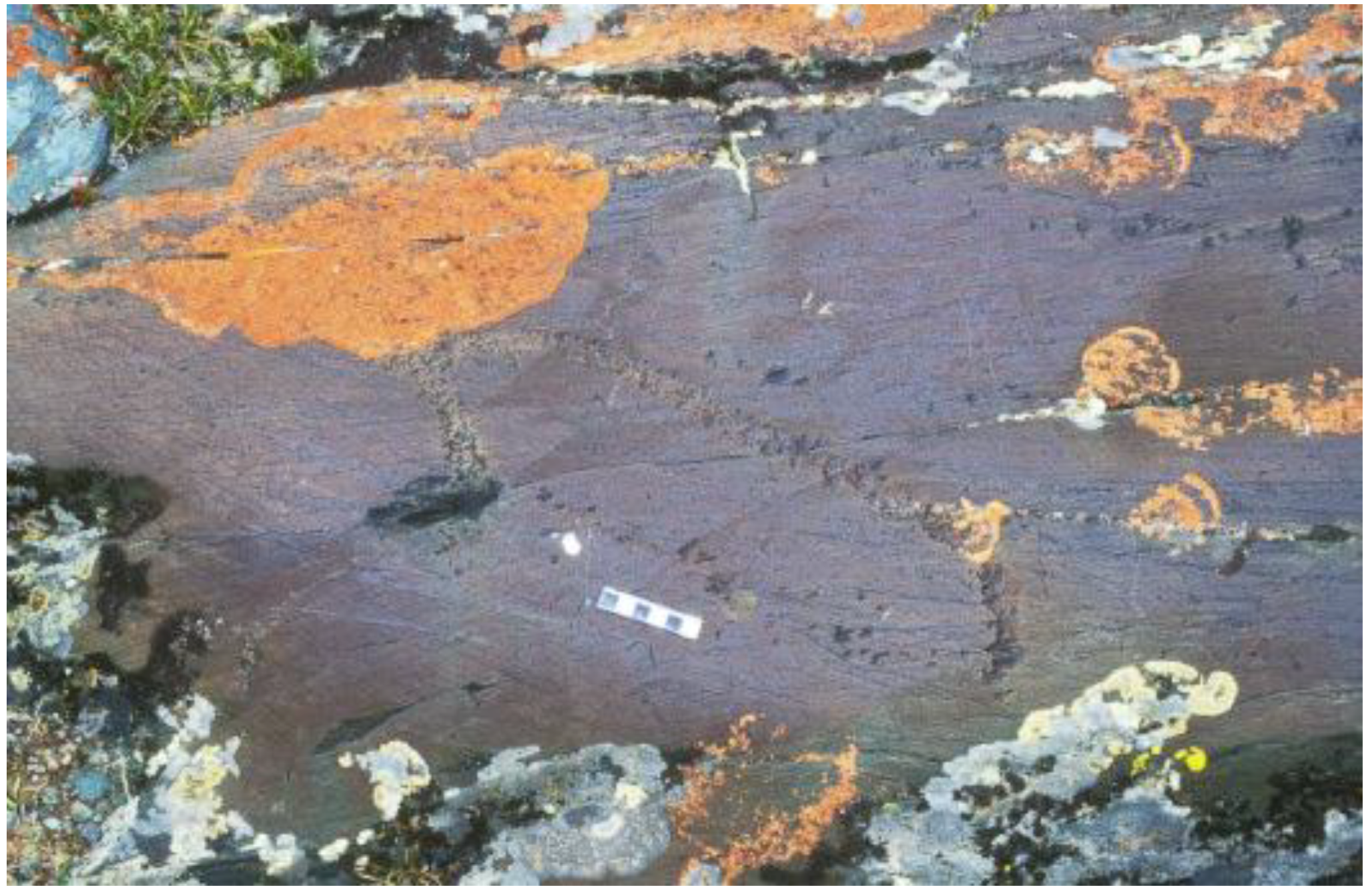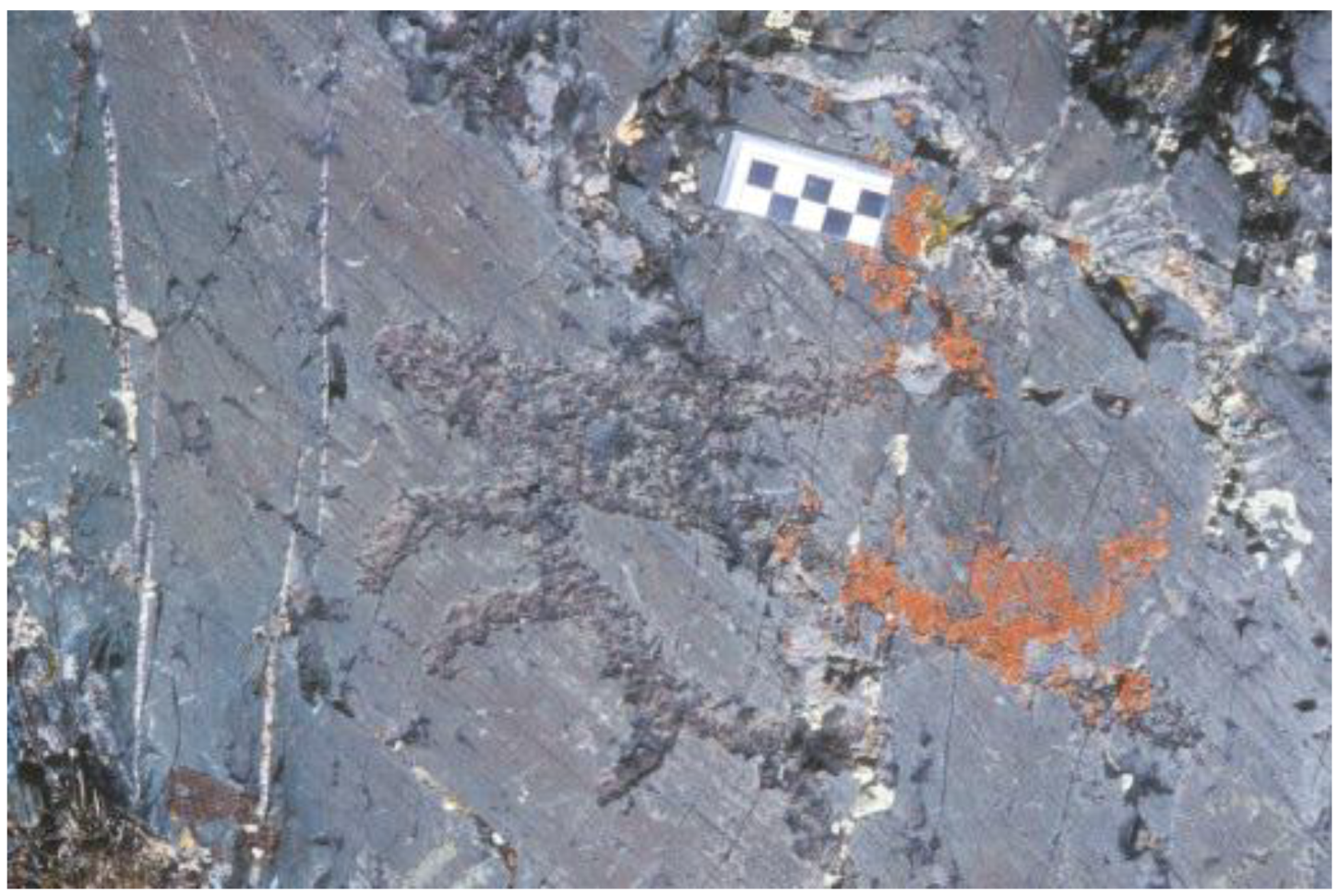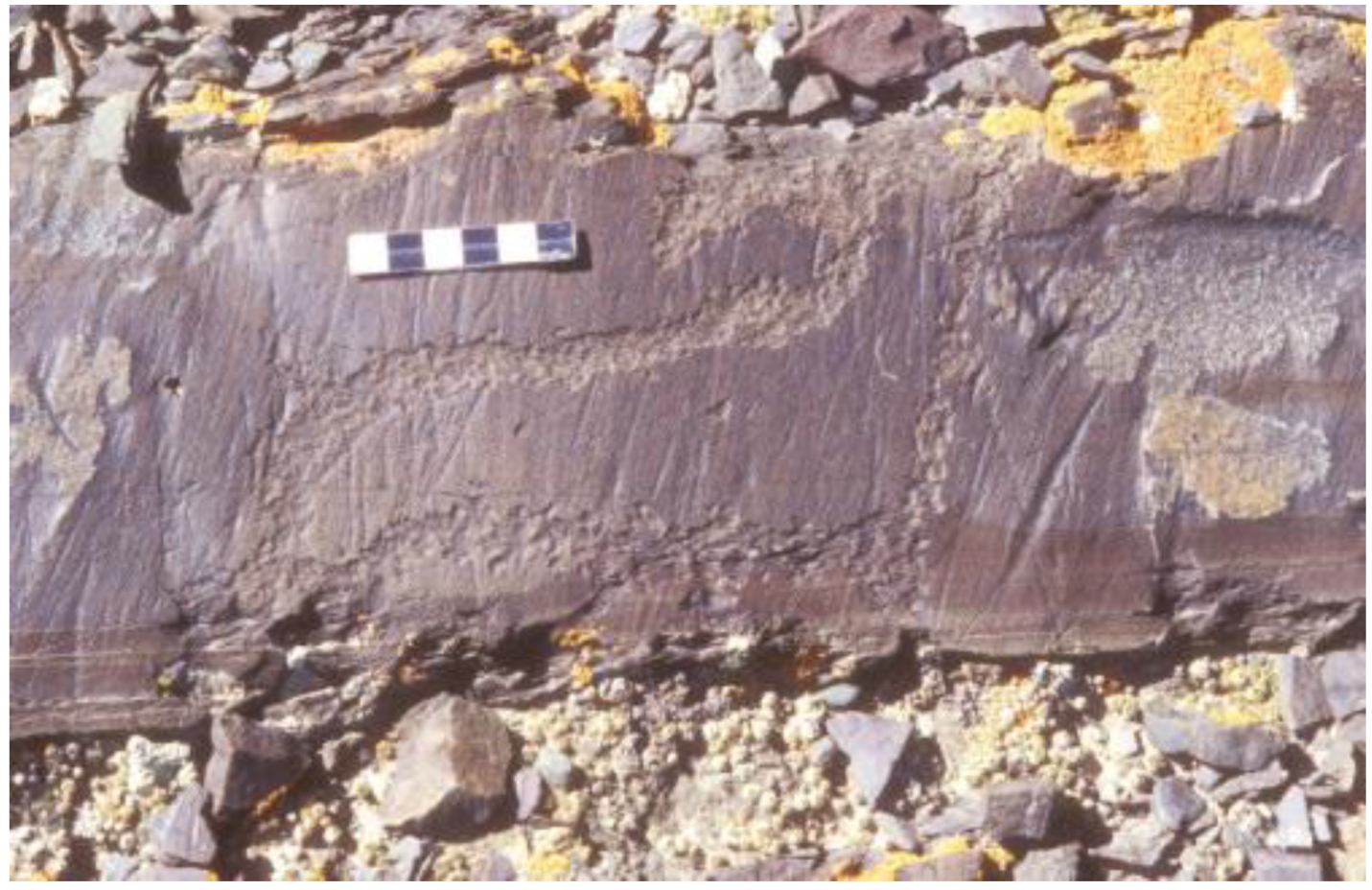3.1. Traditional Approaches to the Dating of Petroglyphic Imagery
Scholars have used a number of approaches to the dating of rock pecked imagery with varying success. Some have attempted to infer the dating of stone images on the basis of excavated materials in the immediate vicinity; but there is no necessary connection between the two. Indeed, the dating of organic materials recovered from nearby burials or ritual structures can be quite misleading. No less problematic is the frequent tendency to use materials gathered from ethnographically attested cultures to both date and explain imagery. Direct dating of petroglyphic imagery is also of dubious value. The exploitation of organic materials embedded within an image’s pecked area—what one scholar has referred to as the “intra-coating detritus” [
9]—offers no good assistance in dating an image. Cemented, as it may be within the microlaminations of the rock surface—or even within the pecked areas of a particularly old image—that material is notoriously capable of offering corrupted dates. No more certain are the bacterial materials associated with iron/manganese oxyhydroxide encrustations that gradually develop on stone surfaces under specific climatic conditions [
10] since these, also, involve substances from vastly different periods. In effect, the organic matter deposited within the grooves of an image or the bacterial accumulations on the surface of the stone could significantly pre-date or post-date that image.
Some scholars have resorted to the relative darkness of patina and surface weathering in order to propose a hypothetical age for a particular image. Within the Mongolian Altai, such attempts are not reliable. Careful examination of the vast number of ornamented surfaces within the large complexes of that region makes clear that patina is as much a function of mineralization of the stone, surface tension (
i.e., the slant of the surface), adjoining vegetation and proximity to moisture as it is a function of age. Images from the early Iron Age found on a vertical surface can be as light as images done in the Turkic period [
11] or, because of the slant of their rock surface they can reflect the process of re-patination that occurred over a long period of time [
12]. Far more useful is the observation of overlaid images, the differences in their re-patination and the cultural indicators of detail. In many cases, indeed, those layers of imagery are decisive indicators of relative dating. There are few such cases involving archaic imagery, but one surface from Baga Oigor II (BO II) offers a useful example of how even in such cases one must look very carefully to understand the overlay in detail (
Figure 2).
The consideration of techniques used to execute an image is a potentially more reliable indicator of period on a gross scale. Within the Altai complexes, petroglyphic images from the Bronze and Iron Ages are occasionally executed with direct, rough blows, but far more typical is an execution indicative of indirect pecking with a finely tipped tool and with a preference for silhouette or partial silhouette [
13]. For example, in a composition from the Upper Tsagaan Gol’s SK_H7 both the stag and the older bull over which it was pecked (
Figure 3) reflect the kind of dense, controlled technique one comes to expect in imagery from the Bronze Age. In this case, overlay and relative patina are useful in deducing relative dating. Even in compositions that appear to date from the middle Bronze Age, one finds an extreme refinement of pecking, the use of indirect rather than direct blows and a preference for silhouette rather than complete contour.
By contrast, there is no variation in the execution of petroglyphic images here assigned to the Paleolithic-Mesolithic period: like the unidentified animal from TS II, they are usually if not always represented with contour lines executed by direct blows. As a result, the pecked marks are frequently deep and uneven in distribution, and the contour edges are rough. This is clearly visible in the image of an unfinished aurochs from Aral Tolgoi (AT_24) (
Figure 4). There are occasional exceptions to the contour rule, most particularly in the case of representations of aurochs, where the head may be rendered in silhouette form and the body in contours. However, in many of those cases (e.g.,
Figure 5), the extreme roughness of the pecking and the simplification of the animal’s body reflect an archaic production.
Beyond the manner of its execution, the unidentified animal of TS II indicates aspects of style that are
always characteristic of archaic imagery in the Mongolian Altai, although they may also appear in the case of later images. These characteristics include a massive body that conveys the animal’s physical presence. This is well illustrated by the superb aurochs from AT_24 (
Figure 4) mentioned above: although the image is only partial, the treatment of the animal’s powerful neck, deep chest and thrusting head conveys strength combined with grace. Other diagnostic characteristics are a static posture and the complete absence of any indication of psychological activity or response even when there are two or more animals on a surface. This is apparent in a group of large profile elk from Tsagaan Salaa III (TS III) (
Figure 6). It is clearly indicated on a surface from AT_16 where the body of a long, elegant elk is crossed by that of an argali (
Figure 7). In this case, as in the case of an aurochs juxtaposed with an inverted horse, from AT_22 (
Figure 8), the animals evince no relationship one to the other despite their juxtaposition or overlay. All these images belong to a period that significantly predated the Bronze Age; more precisely (as will be shown) they may be assigned to the late Pleistocene or to the Pleistocene-early Holocene transition.
3.2. The Dating of Imagery in Light of Paleoenvironmental Constraints: Tsagaan Salaa-Baga Oigor
The last set of indicators that can and must be used to constrain the dating of any pre-Bronze Age imagery involves the consideration of contemporaneous vegetation and climate. This information is absolutely critical. It tells us when environmental conditions were supportive of certain animals and when those conditions had changed leading to the disappearance of certain animals and the appearance of others. In this respect, however, our unidentified animal from TS II (
Figure 1) is mute: we cannot say whether it is an unfinished aurochs or any other animal, and its placement on a ruined outcrop tells us only that the image was pecked at some time after the passing of the last large glaciers in the valley. But that, of course, is unremarkable. The last glacial advance within the high valleys of the Mongolian Altai scraped all the bedrock down to the matrix, erasing any earlier images—if they had even existed.
The consideration of paleoenvironmental issues may be approached through the archaic imagery of Tsagaan Salaa-Baga Oigor. This material is not distributed evenly across the complex as is, for example, imagery from the full and late Bronze Age. Instead one finds pockets of archaic images (
Map 3). With the exception of the unidentified animal of TS II the images are concentrated on the terraces just above the former riparian zone. These concentrations include TS I, scattered surfaces in TS III; the west end of Tsagaan Salaa IV (TS IV) and adjoining sections of Tsagaan Salaa V (TS V); and along the terrace between BO II and the west end of Baga Oigor IV (BO IV). For the most part, then, the archaic images suggest temporary encampments along the lowest terraces over the edge of steppe and marsh.
Map 3.
Distribution of archaic (Pre-Bronze Age) imagery. Tsagaan Salaa-Baga Oigor Complex.
Map 3.
Distribution of archaic (Pre-Bronze Age) imagery. Tsagaan Salaa-Baga Oigor Complex.
The present-day aspect of the Tsagaan Salaa and Baga Oigor valleys offers little information to indicate there had ever been another environment than what is now visible. The landscape is entirely treeless, the slopes covered with rough grasses and the valley floor characterized by a stony plain broken by occasional marshy areas. The obvious scrape and polish of bedrock up almost to the ridge tops on either side of the valleys recreates the presence of valley glaciers during the late Pleistocene. The Last Glacial Maximum (LGM) in this part of Asia is dated to 21.3–19.0 kya [
14], but exactly when valley glaciation came to an end or even whether valley glaciation continued sporadically into the Early Holocene remains unclear [
15,
16]. Seen from high on the slopes or in aerial or satellite imagery, the contours of the valleys reveal traces of significant water erosion in an ancient period and even low dikes and moraines indicative of local and cataclysmic floods [
17]. Such events are also reflected in several surfaces and boulders, particularly around the area where the Tsagaan Salaa enters the valley of the Baga Oigor. For example, a worn boulder lies at the northern edge of TS V and on the side of a plain in which are still visible the scour marks and shoreline of heavy, fast moving water [
17]. The boulder (
Figure 9) was clearly torn out of an original setting higher in the valley and carried along by water until it was deposited here. On the side of the inverted boulder are two archaic images: a large bear-like animal and a horse. Two other boulders at the mouth of the Tsagaan Salaa River reflect a major flood, possibly sudden but continuing for some duration and catalyzed, perhaps, as a result of the breaking of an ice dam at the point where the river enters the larger valley. One boulder, decorated with the worn images of horses and argali, has clearly been smoothed by the passage of water [
18]. Another had been almost entirely buried in silt. Uncovering it revealed an image of an elk that on the basis of style would date to the early Bronze Age (
Figure 10 and
Figure 11).
In the end, the most convincing indicators of past environments are offered by the images themselves and the implications they carry regarding habitat. Certain animals may be considered indicator species, their habitats and dietary needs indicating the existence of specific environments. As grazers and browsers, the elk (
Cervus elaphus sibiricus) represented repeatedly across the complex of TS-BO require both forest cover and forest-edge habitat. At present there is no such habitat anywhere in this region except to the south around the lakes (
nuur) Khoton, Khurgan and Dayan; and to judge from the essentially treeless aspect of the Oigor drainage, there has been no elk habitat for more than two thousand years. Moose (
Alces alces)—represented on many surfaces and particularly in the vicinity of the mouth of the Tsagaan Salaa River—require huge amounts of vegetation including forbs, fresh shoots and aquatic plants. The style indicated by the TS-BO moose images and the hunting compositions in which they are embedded are clearly indicative of the early to late Bronze Age [
19]. At the same time, there are no moose images associated with any Iron Age or Turkic period imagery. Thus we would have to conclude that for a relatively brief period in the second millennium BCE, the habitat of this complex supported the presence of moose. By contrast, it is not surprising that so many images of aurochs (
Bos primigenius primigenius) here and elsewhere in the Mongolian Altai are archaic in appearance or that their images seem to disappear from rock art well before the end of the Bronze Age. Horses and aurochs belonged to the Pleistocene megafauna that ranged across the cold steppe and taiga of Eurasia. They would have inhabited northwestern Mongolia before the expansion of the forests that supported elk, but they could have survived, also, into the later period if forest cover did not displace adequate grassland. Significantly, images of aurochs disappear by the mid-Bronze Age, at about the time when wild yak (
Poephagus gruniens L.) also disappeared and were replaced by domesticated yak. What combination of elements caused the aurochs (and wild yak) to be lost from the representational pantheon is unclear. It does seem certain, however, that the appearance, survival and disappearance of large animals represented in rock art must be associated with the climate and vegetation history of a region [
14,
20].
Images of bear (
Ursus arctos) are relatively unusual in the TS-BO and Upper Tsagaan Gol complexes, but they do exist; and in every case the style in which the compositions are rendered indicate a date no later than the Bronze Age. The treatment of the horse and bear in
Figure 9 strongly suggests a date in the Late Paleolithic period while other images from Upper Tsagaan Gol were certainly executed in the Bronze Age. Bears require the fresh shoots and fruits of a forest environment as well as streams with abundant fish. While fish do still exist within Altai streams, there is only one contemporary environment in northwestern Mongolia where bears still survive—that is, where there exist extensive forest cover and mountain streams. At present, those requirements are met only in the area south of the Great Lakes, Khoton and Khurgan Nuur, although rumors persist that bear can be found in the northern part of Bayan Ölgiy, in the remote Chikachevyn nuuru (range). Bear are still well known, of course, in the heavy forests of the Sayan and Russian Altai Mountains.
Horses have inhabited the Eurasian steppe since deep in the Pleistocene and have been represented by humans since the Late Paleolithic period. Within the Mongolian steppe and mountain-steppe and previous to horse domestication in the Bronze Age, that animal was probably represented by the Tarpan (
Equus ferus ferus) or the Mongolian Takhi, also known as Przewalski’s horse (
Equus ferus przewalskii). Both animals would have required extensive and open grassland. For that reason, a number of images of wild horses found in the TS-BO complex and executed in an archaic technique and style must refer to the period previous to the expansion of forests or after the retreat of that habitat. Two horses from BO II (
Figure 12) capture the heavy bodied aspect of the archaic wild horse, as does an almost invisible horse on a low boulder from the southern edge of TS IV (
Figure 13) and a horse on a blackened boulder from TS V [
21]. The fact that horses continued to appear throughout the Bronze Age together with elk indicate that the contemporaneous environment must have supported both species: that is, forest and forest edge as well as open steppe.
Argali (
Ovis ammon ammon) are regularly represented in an archaic style in TS-BO. This is yet another species attested in Pleistocene levels in Russian Altai sites [
4,
8]. Archaic images of ibex (
Capra sibirica) within the TS-BO complex, as well as at Aral Tolgoi (
Figure 14), echo the remains of that animal attested in the Okladnikov Cave in the Russian Altai where they are said to have been found on the same strata as mammoths, rhinoceros, horses and elk,
inter alia [
8]. Both species require rocky highlands and ridges with alpine grazing; neither is at home in a low-level forested environment. The fact that they were represented regularly in Altai rock art only in the Bronze Age may indicate that by that time, hunters were going higher up the slopes in search of game, and that these animals had become more important as a source of meat.
Within the TS-BO complex, there are a few representations of one other significant indicator species. Two, and possibly four, images appear to refer to mammoths (
Mammuthus primigenius). These include one located on a small boulder in the lower section of TS IV and executed in an archaic manner and with a clearly articulated trunk (
Figure 15).
Another, more convincing image from BO III (
Figure 16) has unfortunately been marred by modern writing. It may be disappointing that these images have no tusks, but their absence may say more about the technical confidence of the artists than about the “true” nature of the animal. If we accept the identification of these images as mammoths, then we are confronted with representations that can only be of Pleistocene megafauna. Whether because of the increasing humidity of the environment at the end of the Pleistocene or the consequent replacement of xeric vegetation by mesic vegetation or, as some would have it, by hunting pressures [
22], mammoths disappeared with the end of the cold steppe [
23]. In the few regional sites for which we have faunal data, mammoth bones appear in the earliest strata, together with rhinoceros and elk [
24,
25]. These images, therefore, indicate an approximate end date (11,500 BP) for their execution.
Each animal species frequently represented at TS-BO—mammoths, aurochs, horses, argali, ibex, elk, moose and bear—reflects a variety of paleoenvironments, some of which would have been incompatible in the same region at the same time. On the Mongolian side of the Altai Mountains one must imagine a cold steppe supportive of horses, aurochs, rhinoceros and mammoths. Within that dominant habitat there existed a mosaic of forests supportive of elk and possibly bear, but lacking extensive riparian zones for moose or boar. In other words, the constraints of paleoenvironmental data together with the manner of executing images and their style offer a reliable means for proposing general dating for patently archaic images. What we need, however, is more certain data relating to the paleoenvironment of northwest Mongolia. Fortunately, that exists; and the clearest source for that information virtually adjoins the site known as Aral Tolgoi, the largest and best-preserved concentration of archaic imagery in northern Asia.
3.3. The Imagery of Aral Tolgoi
The complex referred to here as Aral Tolgoi takes its name from the hill (
Figure 17) lying at the far western end of Khoton Nuur in Bayan Ölgiy aimag, northwestern Mongolia (
Map 2). Khoton Nuur—Pelican Lake—is one of three large lakes tucked up against the high mountains separating Mongolia from China. The glacial origin of Khoton Nuur and of its twin directly on the east, Khurgan Nuur, is evident in the huge moraines that border the north side of the lakes and in the smaller but deeply crevassed moraines on the east and south ends of Khurgan Nuur. To the west and northwest of Aral Tolgoi rise the ridges of the Russian and Chinese borders. On the south and west, the mountains are covered with forests of larch (
Larix sibirica) and pine (
Pinus sibiricus); but above the trees, the rocky peaks and ridges are bare of vegetation and reflect the shapes of glaciers that have now largely disappeared. In fact, the forests found in this far corner of Mongolia are the last of more extended stands that covered stretches of mountainous Bayan Ölgiy in the early-middle Holocene. In valleys to the north of the lakes, remnants of those forests can be seen on north-facing slopes, but these, also, are fast disappearing under the pressure of logging and grazing ruminants.
Figure 17.
Aral Tolgoi seen from the east.
Figure 17.
Aral Tolgoi seen from the east.
By comparison to the peaks around it, Aral Tolgoi has a low profile, its whale shape lying in the center of a flood plain bordered on the north by the silt-laden waters of the Tsagaan Uss (White Water) and on the south by the clear waters of the Khara Salaagiin Gol. Seen from the east, Aral Tolgoi appears to be a long hill covered with thick larch forest on its northern side and western end (
Figure 17). The western half of the ridge is covered by rich grasses on which rest huge boulders left by the glaciers that previously filled this valley. Those same glaciers smoothed the top of Aral Tolgoi and crushed and scraped its rocky outcrops (
Figure 18). These are now most visible on the eastern half of the ridge and on the slopes leading from the ridge down to the escarpments on the hill’s south side. Given what we know of the paleoenvironment of this valley, we can assume that beneath the thick forests on Aral Tolgoi’s north and western slopes might be located other, now lost outcrops.
Figure 18.
Shattered bedrock surface at the top of Aral Tolgoi. View to the east, toward Khoton Nuur.
Figure 18.
Shattered bedrock surface at the top of Aral Tolgoi. View to the east, toward Khoton Nuur.
Until we had identified the rock art on Aral Tolgoi (1996), this site was probably unknown to any but the border guards stationed at the eastern base of the hill. Our discovery of this concentration of imagery was fortuitous: we had been looking for another rock art site referred to us by local officials. As we traveled around the north side of Khoton Nuur in search of this site we were engulfed by a ferocious snowstorm that did not abate until we reached the end of the lake. In this manner we missed the intended site (known as Bilüüt). Having gained the west end of the lake and taken note of a variety of surface monuments from the early Iron Age and the Turkic period, we took a few minutes to climb up on Aral Tolgoi to get a better view of the surrounding floodplains. In the slanting rays of the late afternoon sun, we began to pick out shadowy images of animals on the dark and ruined bedrock surfaces. In this manner we became aware of what is probably the largest and best-preserved open-air concentration of rock pecked images from the late Paleolithic-Mesolithic period. Our earlier discussion of the imagery at TS-BO indicates that while the material from Aral Tolgoi is not unique in its age, it does include a number of animal images that are unknown elsewhere in the Altai Mountains except within Khoit Tsenkir Cave (about which more below). More importantly, it is possible to refer the imagery at Aral Tolgoi to the vegetation history indicated in lakebed sediment studies based in Khoton Nuur and reviewed in the last section of this paper.
Aral Tolgoi includes twenty-four decorated outcrops, numbered from southeast to northwest along the hill’s ridge [
26]. There are, in addition, three large outcrops with pecked images on the hill’s northwest side where it drops down to the valley floor. Much of the imagery along the eastern end of the ridge is hardly visible against the blackened and badly damaged surfaces. As one mounts higher on the hill, the imagery is clearer. Aurochs, horses, and elk dominate the pantheon, but one finds, also, occasional argali and ibex. Excluding a few images of Bronze Age hunters and a Turkic rider, there are very few representations of human beings. The most significant composition involving human images (
Figure 19) includes a large profile figure holding a club within a group of elk, aurochs and a horse. The style in which the animals are rendered, the appearance (probable) of a hunter, and the compositional intentionality suggest a date in the Early or Middle Holocene. A similar or slightly later date may be attached to a grouping in AT_12 including an elk and two frontal figures, one of which appears to be female [
27].
The succession of images along Aral Tolgoi’s ridge shifts between those with simple, roughly pecked contours (e.g.,
Figure 4) and others that may be equally roughly pecked but combine a silhouette with contour technique. While the latter technique may be pre-Bronze Age in date, it is most certainly later in time than the roughly pecked pure contour. In this respect, the composition from AT_16 (
Figure 7), mentioned earlier, is particularly intriguing. The crumbling surface is dominated by an elk with large body, elegantly extended neck and head and with archaic, vestigial legs. A silhouetted argali is superimposed on the elk’s hip; and below the elk, a partially silhouetted elk covers horse. The appearance of elk images indicates that the contemporary environment must have included some forested habitat; that is, the large elk must refer to a point in the several-thousand year transition spanning the late Pleistocene-early Holocene, when forests were beginning to appear around the lake. At the same time, the primitive style and contoured execution of the large animal in contrast to the superimposed and silhouetted animals suggest at least two layers to this composition—the large elk being earlier and the argali and smaller elk later.
The worn image of a massive horse from AT_13 (
Figure 20) and the deeply eroded ibex from the same section (
Figure 14) could have been executed as early as the Late Paleolithic period. In the case of the ibex, the apparent reduction of four legs to two inverted cones argues for an archaic date. Further up the ridge and within section AT_21 is a surface that has been weathered more than most and on which it is possible to make out imagery only in the most oblique of lights [
28]. Included in this panel are at least two profiled, contoured ibex with heavy bodies and massive horns. Here one can say that the worn character of the surface, the treatment of the animals and the dating of analogous images from European Paleolithic sites argue, also, for a pre-Bronze Age date. A similar conclusion applies to the magnificent unfinished aurochs from AT_24 (
Figure 4) and to a contoured elk from AT_23 (
Figure 21). Although the second animal is now obscured by lichen, its simple contours were clearly executed with direct blows using a heavy instrument. The archaic aspect of both images argues for a date no later than the Mesolithic period and probably earlier.
By contrast, a third elk image from the same outcrop bears several stylistic signs of a later date (
Figure 22). The animal appears to have been executed with finer, indirect blows, its body is rendered in a partial silhouette, and its long, slender legs are quite different from the inverted cones of the elegant elk from AT_16 (
Figure 7). Thus differences in execution and style offer the possibility of distinguishing earlier and later images, particularly when they are juxtaposed on the same surface or, even better, when they are overlaid. An example of overlay that assists in relative dating is offered by a fine aurochs from AT_17 (
Figure 23) and the smaller animals underlying and overlaying its body. Returning to the magnificent unfinished aurochs from AT_24 (
Figure 4), although that roughly contoured image is juxtaposed with the image of an elk [
29], the distinctions in style and execution clearly indicate distinctions in time: by contrast to the aurochs, the elk has been carefully and densely pecked out in silhouette fashion, a style indicating the Bronze Age.
The highest and most richly decorated section on Aral Tolgoi is identified as AT_22. Before the development of the heavy forest on the north side of the hills, the section must have offered unobstructed views down to the east, north and south and distant views to the mountains on the west. The surface now is crumbling (see
Figure 18) and a small hut and a marker set up by the Mongolian Border Patrol located at the east base of the hill have obliterated several panels. Nonetheless, it is still possible to make out many images of considerable age, including the badly damaged surface with a powerful aurochs juxtaposed with a fat horse, both executed in contour technique (
Figure 8). These animals could refer to the faunal reality of the Late Pleistocene or the Early Holocene. On the other hand, the massive treatment of the images and their seemingly random juxtaposition argue for a date in the Paleolithic period. Another image is more striking. On a fragmentary surface has been preserved an animal that could only refer to a rhinoceros (
Coelodonta) (
Figure 24). Its body is massive, its head small, and its legs take the form of two inverted cones. Its horn may have been lost in the stone break above its head. The animal is defined by a wide, uneven band of deep peck marks that had to have been executed directly with a heavy instrument. Those who would argue that this is a boar (
Sus scrofa) rather than a rhinoceros should consult the very different treatment of a boar’s body and the length of its head relative to its body: there is, in fact, little in common between the representation of a boar and this animal [
30]. We know that rhinoceros disappeared from the Eurasian steppe before the disappearance of the xeric vegetation on which it depended. By contrast, the boar’s opportunistic diet of fruits, nuts, roots, grasses and carrion requires an at least partially forested setting,
i.e., a date no earlier than the Mid-Holocene.
When we first documented AT_22, we recorded four panels with the images of ostrich (
Struthio anderssoni); since that time, unfortunately, the most complex of these panels has been destroyed by the implantation of an elevation marker on the top of the hill. One existing panel includes two ostriches partially overlaid by a horse (
Figure 25). The contoured and striped treatment of the large birds differs from the partially silhouetted treatment of the horse. The second, now lost panel, included two large contoured birds and two contoured horses (
Figure 26). In the center of the grouping is a strange element, possibly a frontal human figure, but that is not at all clear. The single image on another panel is more primitive but clearly shows the large contoured body, long legs and small head of the ostrich [
31]. A fourth panel includes a large bird, with ostrich-like body but with a strange round head [
32].
3.5. Paleoenvironmental Indicators and Their Relationship to Faunal Species
Analyses of lakebed sediments in both the Russian and Mongolian Altai have supported the reconstruction of the ancient environment of this region as it changed from the end of the LGM to the onset of the late Holocene (c. 4.5 cal yr ka BP). The research site most relevant to the dating of the complexes discussed here and, most particularly, to Aral Tolgoi, is located at the east end of Khoton Nuur. According to the scientists’ analysis of the pollen record from that site [
20,
35,
36], before 11.5 cal yr ka BP. the region extending from there to the north, was characterized by cold steppe covered with xeric vegetation (Artemisia, Chenopodiaceae, Betula nana). With the gradual amelioration of climate between that date and 9.5 cal ka BP, spruce (Picea) dominated forests slowly expanded to create a closed tree cover, and mesic vegetation gradually replaced xeric assemblages. This trend continued until approximately 5 cal yr ka BP, by which time a decrease in moisture and lowered lake levels and temperatures resulted in the gradual replacement of spruce by larch (Larix) and pine (Pinus sibirica), the general retreat of forests and the expansion of dry steppe. By 3,000 years BP, northwestern Mongolia had returned to a steppe environment in which the only extensive forests, limited to a narrow band along the Chinese border, are dominated by larch. Other studies have established corroborating evidence for the larger region of Siberia [
37,
38], northern China [
14,
39] and northern Kazakhstan [
40]. At this point there exists a detailed understanding of the fluctuation of climate, lake levels, and flora over a large region, including that of the Altai Uplift, over a period of more than 16,000 years.
While there have been extensive studies of the cultural implications of climate and faunal-human interactions within the larger region of North Asia, virtually no studies have been undertaken in the Mongolian Altai. Whether scientific excavations in these high valleys would reveal useful faunal remains is unlikely or, at the least, unknown. There are, by contrast, a number of studies of habitation sites in adjoining regions that offer relevant comparisons. As has been mentioned, caves within the Russian Altai indicate the human exploitation of woolly rhinoceros (
Rhinoceros tichorhinus), horses, argali and yak during the Sartan period glaciation. Other studies have indicated within the upper Yenisei region the existence of megafauna such as aurochs, woolly mammoths, and rhinoceros down to the end of the Pleistocene, as well as the existence of reindeer (
Rangifer tarandus), argali and steppe bison (
Bison priscus). In the immediate post-LGM, the sites revealed the exploitation of moose, aurochs and wild horse [
6]. To the south, at the site of Xiaonanhai in the lower Yellow river basin, rhinoceros and elk (
Cervus canadensis),
inter alia, have been attested in the period succeeding LGM [
41].
Scanty as this information is, combining it with studies of climate, vegetation and fauna for the larger Eurasian region allows one to bracket faunal possibilities in the Mongolian Altai. Whether the petroglyphic images discussed above refer to species valued for practical purposes or to species that enjoyed a cultural value other than that of game is unknown and possibly unknowable. It would seem certain, however, that the archaic images we find in Mongolian complexes refer to species contemporary with the artists who executed them and not to “cultural memories.” With this understanding, we can propose the following guidelines. During the Late Pleistocene, northwestern Mongolia was part of the “Mammoth Steppe” that covered the northern reaches of Eurasia [
23,
42]. While generally characterized by a dry and cold expanse of xeric vegetation, it was dominated by large grazers—that is, megafauna such as mammoths, woolly rhinoceros, horses and aurochs, as well as ostrich. One must imagine, however, that by the late Pleistocene that steppe environment was increasingly broken by a mosaic of boreal forest and mesic vegetation [
43].
Woolly mammoths and woolly rhinoceros are thought of as archetypal animals of the middle-late Pleistocene. The southern limit for both species goes directly through the region of present-day Bayan Ölgiy aimag [
42]. Rhinoceros appear to have disappeared from Eurasia by 12,000 yr BP, while mammoths lived on into the early Holocene in areas of the far north where steppe habitat survived until as late as 8000 yr BP [
42,
44]. Within the larger Eurasian steppe zone, the survival of megafauna was thwarted by the expansion of mesic vegetation, coniferous forests, and a soil base unable to support the weight of the large animals. The most archaic images of elk from our Mongolian sites (e.g.,
Figure 7) suggest an emerging mosaic of open grassland and protective forest edge in the late Pleistocene. The fact that there are no clearly identifiable images of moose at Aral Tolgoi argues that when this far valley was inhabited, vegetation was dominated by the harsh species on which megafauna depended rather than by the browse required for moose. (With that in mind, it is striking to note the distribution of moose imagery within the complex of TS-BO—around what must have been riparian thickets along the Tsagaan Salaa and particularly where it joined the valley of Baga Oigor [
45]).
In northern Mongolia, ostrich—which in North Asia required an arid steppe environment—may have lasted until 8.9 cal yr ka BP [
46,
47]. The ostriches at Aral Tolgoi indicate the previous existence in that region of dry grassland and xeric vegetation, while the rhinoceros image—like the mammoths from TS/BO—indicates a contemporary cold steppe environment. The work of several scholars on the survival of ostrich within Mongolia [
46] indicates that
Struthio had disappeared by 8,900 years BP. By that time, coniferous forests and mesic vegetation would have replaced the arid steppe environment on which ostrich depended. Thus the images of
Coelodonta and
Struthio establish an early phase for rock art at Aral Tolgoi with a beginning within the Late Pleistocene (Late Paleolithic) and before 12,000 years BP and termination within the Early Holocene (Early Mesolithic). Presumably many of the archaic images of aurochs, horses and possibly ibex can also be dated within that span of time. By extension, we can confidently assert a similarly bracketed early stage for the mammoth images and for the most archaic images of aurochs and horses at TS-BO. It is probable that to that period, also, date the most archaic images of other typically Pleistocene animals such as aurochs and horses. When ibex and argali would have appeared within the paleoenvironment and the pictorial record is not clear, although (as noted above) both species are attested in Pleistocene layers from Okladnikov and Ust’ Kan caves in the Russian Altai [
24,
48]. To judge from the imagery of those species at Aral Tolgoi—where some representations have all the archaic aspect of the oldest horses and aurochs—they may also be markers of the late Pleistocene or of the Pleistocene-Holocene transition.
